
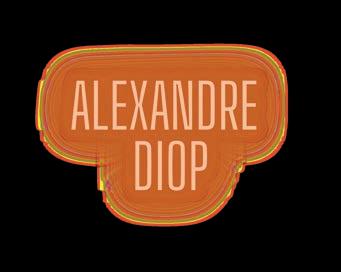
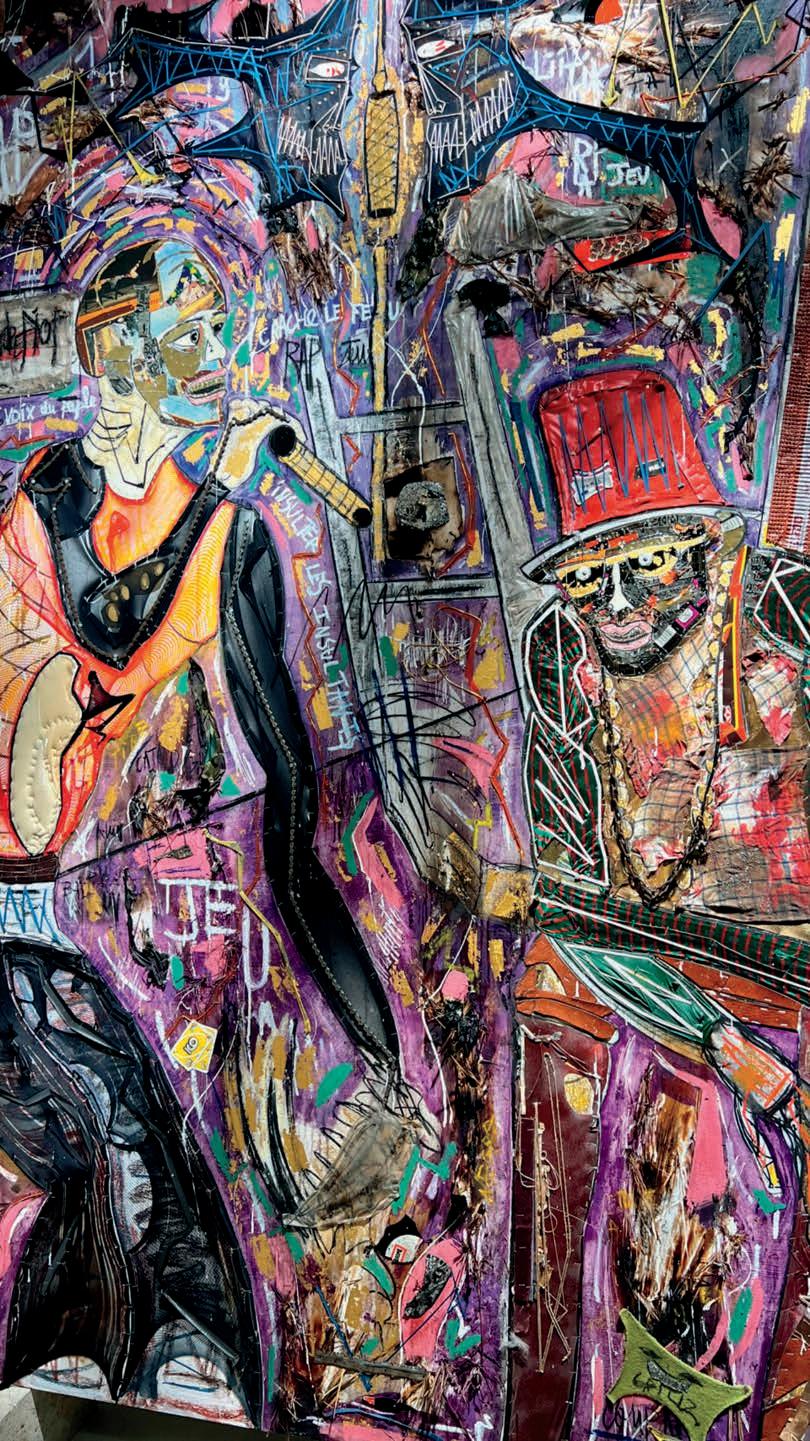










It has been a hectic year in the art world. As I racked up miles feeling hostage to my airline (often delayed), I would walk 20 miles a day and sleep for a day or two when I got home. It was all worth it because, admittedly, I love the buzz. As a collector, I appreciate seeing artists do well. As Editor in Chief of Portray, watching the headway of artists we have highlighted is exhilarating. Affirming there is nothing else I would rather do. Spring was busy with Dubai, New York, and Basel. People were back out with a vengeance, and it felt incredible. So when is it too much?
The Fall alone had Barcelona, Frieze London, and the first year of Paris + Basel, Korea; then Japan hosted a soft opening, keeping art advisors and collectors on their toes. At the auction houses, we watched billions of dollars in sales from two collections between the Macklowe and the Paul Allen's troves. Again, sending the headlines to Bloomberg. We keep telling people to infuse art into their portfolios!
One cannot help but wonder what will transpire in the New Year. Still, one thing is for sure, a lot of beautiful art was created during the Pandemic. I am inclined to name this new era of work "Post Pan." We observed an array of styles come to the surface. Large-scale, fantasy, still-life scenes and many figurative, wistful, lightly painted, reflective works were sold this year, anticipated by eager collectors. In this issue, we are happy to share an array of many different styles of talent, all with unique messages. But, more importantly, the story behind what we see is a person and their passion, pain, motivation, lessons, and messages. None of these stories is just about art. Instead, they are about extraordinary people with the courage to show and put themselves in their work and out there for us, and we are in awe of them.
As we wind down for the holidays, I am again reminded of how fortunate I am to be a part of the creative world. It is an honor to tell our readers about these artists' voyages and dedicate this magazine to life's subtle and sublime moments and, most importantly, the human connection. Sending love to you all.

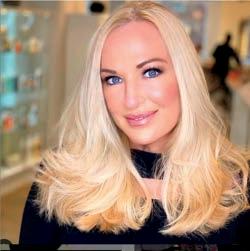 ~Donnalynn Patakos
~Donnalynn Patakos
 Written by Victor Sandoval
Written by Victor Sandoval
"What is real?" was the first question I asked Hermes Berrío whenwesatdowntochat Theconversationthatevolvedfrom thatonequestionwasinsightful, inspirational, andeducational Tobegin, IsupposeitwouldhelptoclarifywhyIaskedhimthat question Ireadoneofhisinterviewswherehestated,"Realityis all around us, but to understand what it means truly, I had to become a husband and a father." It made me ponder his meaningandinterpretationofrealitybasedonfamily Hermes' worksareallaboutfamily, butnotjusthisimmediate family; he also paints the family that is his neighborhood, his surroundings, andhisexperiences Itisasifacinematographer wouldpaintamovieinsteadoffilmit Thismovieshowswhathe islivingandwitnessingdaily Intheeverydayactivities hestrivestocaptureandexposethe beautyofthemomentsthatgetsuppressedandcomebackto us with a familiar scent, that transports us to another time, another place, all but forgotten Sometimes the simplest day to day moments are the ones we later miss the most That is what Hermes Berrío documents and paints, the simplistic beautyofoureverydaylifewealltendtoforget

Asheexpresses,"Myworkiscompletelybasedonwhatisrealtome, but what is real to me? After a deep inner search, I wondered where does real come from I realized that the word real is a very subjective word thatmaynotapplytoonlyonemomentI'mliving Realitycanbeadream, afantasy, oranabstractplane Whatisrealtoyoumaynotberealtome." It is no wonder Hermes wanted to be an anthropologist when he was growingup, drivenbyhispassionfortheuniverseandtheinfinite Inmy opinion, he is an anthropologist in a sense, studying and documenting ourhumanityandconnectingtheviewerwithit, throughhisart Hermes has seen his fair share of difficulties in the pursuit of defining what is substantial to him and his art This includes the heartbreaking loss of his infant son As he explains, this was one of the most challengingperiodsofhislife Helosthisdesiretopaintformonthsas hecouldnotfindaconnectiontoartwithinthesadness

Aself describeddevotedman, helosthisdesiretopray, questioning God and the reasons for such loss Yet somehow, hefoundrefugeintheloveandpositivenessof the ones he still had around He took that sadness and turneditintogratitudeforwhathestillhas, family Hesharedwithmeamomentthathappenedtohimafew days before while bicycling to Virginia Key, where he wenttowatchthesunrise
"IbegantoprayahailMary, butIsaidtomyself, I'mgoing tojustbequiet
Nature, what I'm hearing at this moment is my mantra: thewaves, thebreeze, theairaroundme Irealized, wow, thisisalsoaformofprayingandgivingthankstoGod." Everything that surrounded him was something to be gratefulfor TobepresentwastheHailMary Ifoundthis to be one of the most profound moments in our conversation Hermes sees gratefulness as the cornerstone of his life No matter the hardship, the rejection, the loss, the difficulty, his art expresses appreciationfortheday to daylifehegetstoenjoywith thoselovedonesaroundhim

His works are large and then larger in nature The subjects of his paintings are usually life sized, allowing the canvas to transmittheenergyofapalpablepersonwhenyoustandinfrontofthem
"Itallstartswithaphotograph," hesays
His process begins with documenting his surroundings, taking pictures on his phone, and then selecting the photographs thatspeaktohimthemost Fromthere, theideaofapaintingisborn Hedoesnotcagehimselftoastyleorthepursuitofone idea, butheletsitflowinhiswords
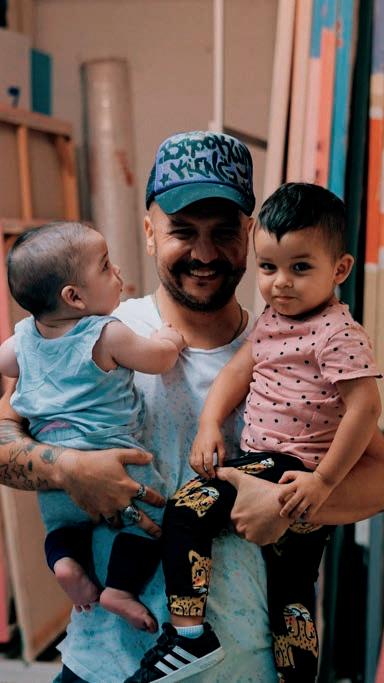
"Thecanvastellsyouwhereitneedstobeenhanced."
All of his paintings have an element of mixed media, something he defines as "Up cycle." I asked him why that word? He explainedthatmostpeoplecallitrecyclingorrepurposing, buthebelievesthatheisusingmaterialsforabetterpurpose, so heis "Up cycling."

VS- Whatisreal?
HB- Atimelessillusion
VS Howdidbecomingafatherhelpyouunderstandthe realityaroundyou?
HB-"SinceI'mafather, Irealizedthattheimportantthings inlifeareverysimple Lifeisgivingyouaboosttokeep going, andyou havetoholdontight!"
VS- Youcapturethesignificanceofeverydaylife Why isthisimportantconsideringthecurrentpoliticaland globalcircumstances?
HB-"Myworkvalidatestheresponsibilityofthevisual artistasthehistorianofourtime; itisarecordingdeviceof theworldtoday Byabsorbingandprocessingtheworld aroundme, ideascomethroughmeandbackintothe world pointingoutwhatgoestypicallyunnoticed."
VS- What is everyday life like for you as you observe the neighborhood?
HB- "It is the backbone of my vision From street signs to abandoned buildings, from graffiti on the walls to ordinary situations, is a reflection of the human condition Finding inspiration in these unusual yet commonplace experiences, I explorethecomplexityofsuchsimplemoments."
VB- There is an energy to your paintings. Perhaps the large formataidsinfeelinglikeapersonisstandinginfrontofthe viewer How do you hook and transfer that into the canvas whenyoudoyourworks?
HB- "The subjects of these paintings are ordinary people, real people that live and do what everyday people do I look for commonplace experiences, where you can see in their expressions and poses their true being, the meaning of their extraordinary life By exploring the complexity of these minimal momentsbetweenthepaintedandthepainter," "

"
VS - Some of the titles of your works have a bit of dark irony in them ; why?
HB - " The titles of my work re imagine , re arrange , and transition visions of a cultural and personal landscape , seeking new ways to interpret one ' s truth visually I always want to connect with people through simplicity I ' ve never liked complicated art , where you must read a whole book to understand it I believe that the titles being common phrases or sayings make it easier for the viewer to digest the work , which is also important because I believe art is for everyone You do not need a Ph D in art history to understand my work Art is a fundamental expression of the human being , and it has been like that since the time people lived in caves All the titles in my works relate to things happening in my personal story ."
VS - When did you start involving mixed media in your paintings?
HB - " I have always been a Fan of Up cycling objects , giving them new meaning and life through my work I see materials and collect them After deciding to study art , I moved to New York from Colombia when I was 17 years old I never had enough money to purchase the yearly list of art supplies the school requested ." I was in a position of I either ate or had school supplies This is why I always liked experimenting with materials created with a different purpose than what I gave them ."
VS - What would you like the world to know about you as a person and as an artist?
HB - " Our world occurs on its terms It is our responsibility as humans and as artists to know as much about it as possible , to focus on and find new ways to interpret the purest aspects of life These sometimes hide the most important and extraordinary things for the human imagination

 WRITTEN BY DONNALYNN PATAKOS
WRITTEN BY DONNALYNN PATAKOS
Gene Dunn stated, his face not yet on screen, gently moving the chair in place before sitting down. I beamed, nodding my head in admiration; and for a split second, as he said the words, a flash vision of what it may look like came over me, but he was on to something else, now on full screen, not noticing my reaction, as he settled in. He really is perfect for this article, I mused within as he spoke, and I listened.
We have these talks from time to time. I can sense his shadows, and I recognize his light. But, more importantly, I know his heart. I had an idea for an article, perhaps multiple. To follow one artist’s progress, watching their evolution over time. The idea of possibly capturing the switch in one’s energy, witnessing what changes when the action turns into passion.
To notice an evolution requires tremendous activity, as it has an emotional currency with a significant return few experience, but many are attracted to. The muscle is in the hustle. Nobody escapes this because paradigms are made from this invisible force. In the longspun road, it is inside every one of us. Study history hit repeat: loop that; in every second of every day, it happens. Yet, in the here and now, who and what, and how do we learn? Emulation of propagation? Influence has an entirely new meaning today; Where does one find the real deal? Someone not so contrived, with resolve, clear resolution, and inner determination to see it through? I’m happy to introduce you to him, and he lives in Brooklyn.
I have known Gene Dunn for thirty years. He is so intensely deep-felt, well-read, and philosophical, also at the same time, wildly free. Moreover, and important to note, he is uniquely his own person. He will don a faux fur jacket, sweat pants and finish it off with flip-flops. He used to have a big maroon/plum-colored car, meticulously polished, which completed the vision flawlessly (he has since swapped for a smart car, which is hilarious knowing his size). He’slikeacharacterinamovieyouwouldwant in your get-away caper for more than one reason.
He says I love you generously, without hesitating in the most exquisite sense. The words are spoken with a silent message of hope for everyone who comes in contact with him. Gene makes videos telling everyone who sees them that “You are loved, protected, and you are important.” He is a “Killer Teddy Bear” who hosts a podcast called the “Gentle Art Podcast,”whereheinterviewspeople(including myself) of all walks of life about their journey, and it’s really engaging. This is Gene right now. But,ofcourse,thishasbeenGeneallalong.

"It'spouringoutofme,andIdon'tknowwhereitis takingmeandIdon'tknowwhereit'sgonnago,butI'm showingup!"
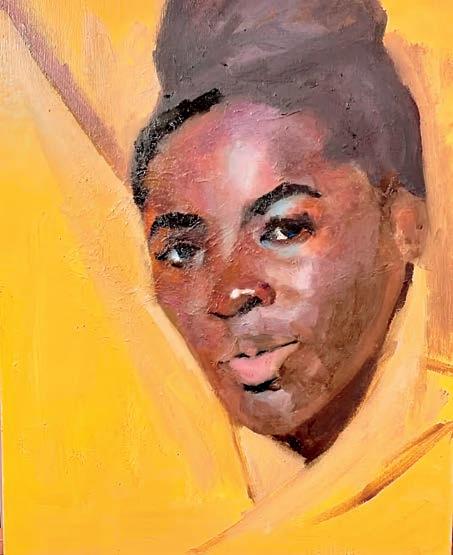
So, when I noticed he was doing art a few years ago, I paid attention because I just knew something exceptional was brewing. He never walksonawornpath.IknewhewastheEmerging artist I wanted to share and I was thrilled with the notion. You see, Gene is a giver. I would wait for his next painting or the next sketch and then he startedsomething,whichhedoestothisday. He puts a picture up on his Instagram story and writes, “Do art every day.. Here’s Today’s sketch” and encourages anyone who sees it to try it with him. A panda bear, a vase, a taxi cab, anything.. and then I noticed over time (the silent nod), other people began to sketch with him, and he would show their sketches too. It was now a team sport. He told me people will write to him and tell him how happy they are to be sketching again, life, jobs, time gets in the way, and thanked him for opportunity to do something they love to do. My favorite part of participating would be writing to him, from time to time, letting him know the progress I observe from afar. This is a story worth telling and my heart feels full to even type these words.Icansaywithcertainty,thereisnooneelse quitelikeGeneDunn.
I spoke to him over the months in person and on zoom and calls, keeping up with him noticing the progress in his confidence within the brushstrokes, and layers and how his work emits soul, and an intimacy that says, I get you, and I feel you. When I saw his portrait of Keith Richards, I thought of pictures I have seen in Museums that cannot capture the profundity that this work does, and proudly showed my friends. He doesn’t dabble. He will explore different mediums, and will enjoy and experience whether it be watercolor, andoils,paperorcanvas.
When you think about the term “EMERGE,” what goes through yourmind?”
I think about Good ideas emerging or bubbling up and the courage to respond to those good ideas- A kind of realization that there’s evermore good when we let go of a past identity/way of being. What do you think makes an artist an “Emerging artist?” and whendidthatswitchgooffforyou?
I think the moment we as artists realize we are valuable and have something to share, coupled with the idea that the viewer (witnesser) has value and importance in that space, creation emerges for me that’s where Art and Love exist in the most powerful form.
I experience it more like shedding. Shedding fears that whatever gets created is worthless or that I’ll never be as good as other artists and really leaning on creation and the inclusionary principles that I adhere to.
Doyouliketopaintscale,orprefersmallerworks?
I kinda feel like the size of the work reflects the stage I’m at in development. The less I’m trying to control every little detail, it seems like the size of the work naturally expands. I certainly am not in a rush to shortcut the experience, so I hope as I grow, the result will as well. Is there a medium you favor more than others?
As a daily practice, I like to work in several mediums – starting with small pen and ink sketches, larger graphite/charcoal drawings, and then moving to watercolors and then finishing the day with oil. For me, oil painting is is the jam and the one I’m most intimidated by. It’s such a powerful and exquisite medium that in my imagination connects me to every other painter, past, present and future and in some ways every person that’s ever viewed a painting.
Doyoutitleyourworks?
Sometimes I’m concerned a title might take away from the viewers experience. However, there are times when I’m left with an idea at the end of a painting that I find wants to be attached to the work, and sometimes it’s a quirky title that inspires me. For example, I listened to Iggy Pop’s BBC show, and he referred to himself as Igor Popodopoulous. That was so cool! I thought, Ohmygosh, I want to spend more time with this guy named Igor Popodopoulous. Get to know him better. So I did a playful portrait to capture our time together. Kinda like a Polaroid picture and titled it Igor Popodopoulous. In that way, I don’t think a title takes anything away from the viewer’s experience but instead gives this interesting story a cover page.
Tell me about “Time” when you are working.. what are you experiencing I think a lot about this metaphysical statement, “If it’s mine to do, then I can do it.” This time thing can be a little sticky, especially when thoughts of age, career, etc, start trying to argue with me and distract me from the work. I know lots of people say that time stands still or disappears when they’re working, and some of that’s true for me as well – very meditative. Interestingly I feel time is actually more malleable when I’m doing art and therefore doesn’t just stand still… but I’m actually gaining time while doing the work. A deep sense that “Time is on my side,” like when we turn back the clock and poof, there’s suddenly an extra hour.
Does painting quiet your mind or wake you up to the possibilities?

I don’t really look to quiet my mind. I am always trying to align myself with creation and am listen for it. What I most desire is a continuous awakening to good ideas and letting that just guide the brush.
How much time do you spend in the studio, and has that becomelongerasyouhavegottenmorerefined?
I find myself wanting to engage with the work more and more. Like the more I do, the more I want to do. Refinement seems to always always be part of the process. I’ve learned that progress is natural and refinement is a result of engaging with the work daily. It never fails to deliver something good.
What kind of things do you say to yourself after you finish a piece? One of the things I have to be very mindful of is self judgement. I don’t want to be overly critical and kill the desire to keep working. I like the idea that “Love loves all of its creations” as a way to find balance between two points. Is there more to do, experience or progress with this piece? Or am I being too critical and killing it for the next painting? Most times I find it’s best to just let things be and trust that I can go a little further next time. When did you first know this is something you wanted to spend more time on your craft in a professional capacity?
I think I was very fortunate growing up in NYC — there was a ton of art via the museums, street art and even in school. It was all around me. I remember seeing a film of Jackson Pollock painting in the third or fourth grade. In those days they used to wheel in a giant projector with large 8mm canisters, pull down the screen that hung over the black board, run the film through the little spindles, turn off the lights, and boom, we were right there with Pollock. I can still hear that clicking noise the film makes as it runs. I knew then and there I wanted to be an artist. I went to the HS of Art and Design, and there was this sorta promise of a good art education in my head, but what really happened was I became intimidated by other artist and insecure about my ability to earn a living, so I gave up the idea of being a working painter and turned my attention to Martial Arts. Growing up very poor left me feeling that Martial Arts was a better way out, so I traveled the world competing and opened up schools in Brooklyn. At some point, though, I became concerned for whatever reason that there was nothing tangible to leave behind. The legacy problem. I don’t have kids. My work in the martial arts, while I believe it provides value for people, is not really tangible in the ways that I needed it to be, so I turned to back to my love of painting. Which, reconnected me to creation, which is eternal. The paintings are just a record of that, a manifestation of that relationship.
Time"I feel time is actually more malleable when I’m doing art and therefore doesn’t just stand still… but I’m actually gaining time while doing the work"GeneDunn
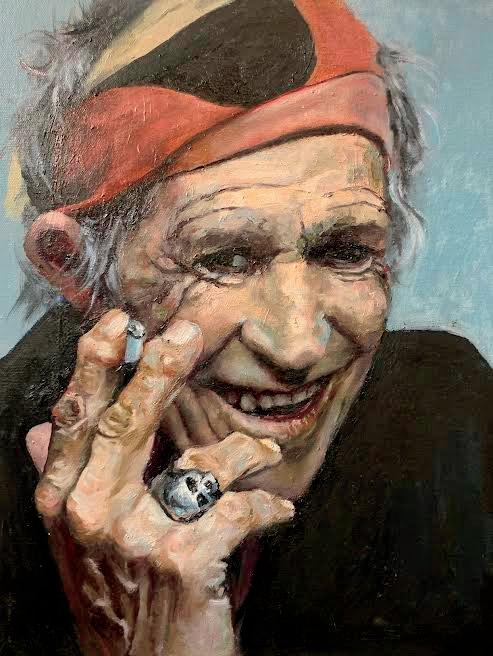
Do you even want to put yourself in a box- like labelingyourselfanabstractartist?
I don’t believe there is a box that creation comes in. Why would I want something infinite to be finite? I’ve already self-imposed too many limits in my life. I’ve madethatmistakealready.
Which work do you think you have worked on, not even necessarily finished when you knew you had elevated your technique and even surprised yourself?
I feel as though when I’m working, I’m trying to find the subject, and it’s trying to find me. If and when we meet on canvas or paper, it’s always a brilliant moment. So inspiring sometimes that I won’t be able to sleep for hours after I finish up at night. I Love it! More specifically to the question, the Keith Richards portrait is one where I worked very hard, but paradoxically, I look back and don’t recall slaving over it. It’s more like I have no idea where it came from – I was just an antenna for it the wholetime.”
I’mreallyfuckinghappyaboutthisinterview. I’m inspired by the Do Art Everyday moment. In particular, the drawings people are sharing. It’s all very moving. I’m inspired that my love for art is taking me in wonderful directions, not all of which I understand, nor doIhaveto.
Howwouldyoudescribewhatyoucreate?
What I’d like to think is moving through me is something of a union of Jackson Pollock’s immediacy and atomic energy coupled with the grounded forms and delicate color nuances of Paul Cézanne. The indescribable things that gave their paintings life are things I’d love to beabletoexpress.
You often encourage others to join you on your Instagram and encourage them to sketch something along with you. Have you ever gotten messages saying howyouinspiredthem?
Yes, a large part of the Do Art Everyday movement is former Art and Design graduates who stopped doing artaswell.
They’ve communicated that what’s been inspiring to them is the consistency — the never-quit pursuit of this, the daily practice — having someone show up every day supporting their art and doing it along side them.
The shared experience is very powerful, and If martial arts taught me anything, it’s chop wood carry water. Consistency trumps insecurity. It’s been my privilege to doarteveryday.
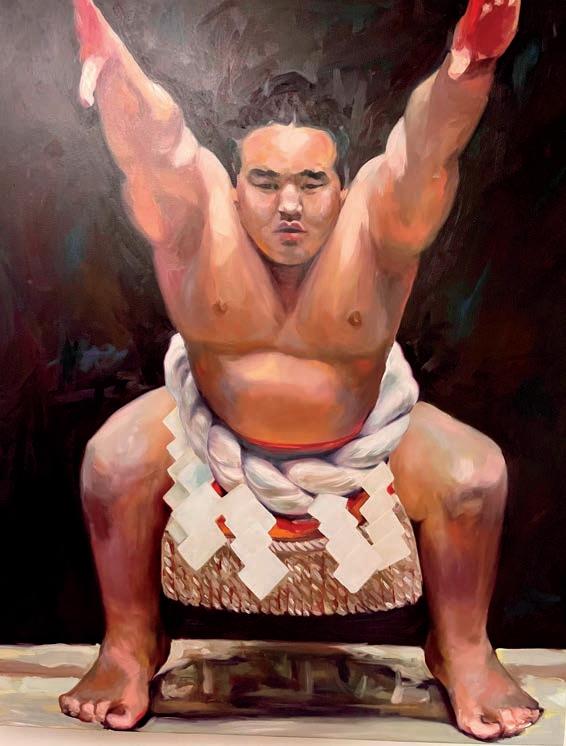
Where would you like to be in a year technique developmentally and what are you doing to achievethat?
I’m so interested to see myself!! What I’m really after is expressing how I view life through painting. At this point, I’m humbly showing up at the easel, sorta like an altar of sorts, every single day and putting paint down on the canvas, trusting that it will take not just myself but those who view the work someplace good. I’m so looking forwardtoit!
I have been blessed with a very good teacher and a great landscape painter in his own right, Casey Inch. Genius guy! He knows just the right moments to impart gems of knowledge that allow me to experience the fullnessofpaintingformyself.
anticipatingSomelazeafterdreaming,therightmomentforthesuntoarriveWhileTobasqueinittofeelwarmandsafeothersstretchtowardsthesunshineandcarryitHeAndthatiswhoGeneDunnis sharesthelight IfHewillgivesomeofhis Generousyoudon’thaveany Hospitablewithhisthoughts withhisresponses OneHeelevateshisgroundbeneathhim Leading,stepatatimelearning,andlovingHeisemerging...




 MOYOSORE MARTINS
MOYOSORE MARTINS
Time, development, and the creative soul have occupied the hearts of human beings throughout the centuries, documenting a vibe, a paradigm presented uniquelythroughtheireyes.
Each one of his canvases, personifies a recall, chronicling a journey provoked by another time and another place. These rooms represent stages of growth, love, sensation, contribution, protection, apprehension, and gratitude inside an astounding collisionofculture,color,andsentiment.
Mòyósóréexplains,"Thereisnosuchthingasmarking time; time marks you. Like everything has happened before, in a loop, and when fulfilled, you hit replay and do it again. So everything you wish for, everything you want,isrightinfrontofyou."
Mòyó says often he repeatedly finds himself in situations where he feels as though he has been there before in that exact place, in that exact moment.
There is a vibration that some people recognize — a parallel interference as they blip out of participation in the place they may be. Like you are on one radio station listening to your music, and somehow perceive a transmitter nearby, and in another room, others are simultaneouslyaccessinganentirelydifferentsituation and experience. Time runs parallel, and you cannot move over to the other line of time, but fragments, cognition, and comfort bring you to another, different situation and state. A fluttering of recognition flashes andyouarriveinaplaceagain,likeanoldshoeyouput onahundredtimesandhavewalkedmanymilesin.It's thekindoffeelingthatcomesthroughyou,nottoyou.

Mòyósóré Martins waits with his hands on the canvas and asks, Why? When he receives the message,hebeginsandpaintsfervently
 Photo courtesy of Portray Magazine
Photo courtesy of Portray Magazine
The Greeks would call this "Anamnesis," which is recollection or reminiscence. The idea is that humans possess innate worldly knowledge, as the soul is immortal. Thus, with each new life (and trauma of birth), we forget details of past lives, and learning consists of rediscovering or uncovering the knowledge already within us. Plato explained this as "a Knowing."
A straightforward way to explain this "knowing" is to ask how many fingers you have on one hand. The standard response would be "Five." But how do you know "Five is five?" —because you do. It is that innate certainty so simple, yet so complex that escorts us on our journey.
The setting sun, and the rising moon in Lagos, Nigeria, delivered intense dreams to Moyo Martins as a boy. These dreams were, at moments, overwhelming and would free themselves in his sketches and drawings
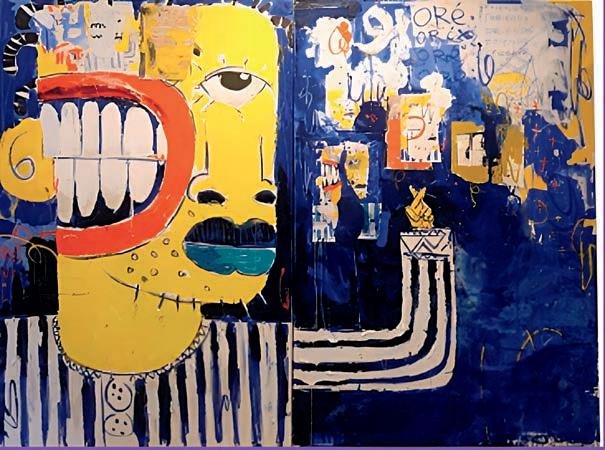
His talent developed, as did his sensitivity to feeling familiarity in his surroundings like he had been there before. A type of Nostalgia, in his language, he calls it IRANTE- Nostalgia. Which is the name of his first show in Los Angeles at the Path Gallery, in Westwood Village, opening September 18th.
After getting to grasp Moyo's personality very well, I said, "You know, one thing I noticed about you is that you are always so grateful. So, if I had to choose a word to describe you, it would be grateful." He laughed and said, "You know what? That's what my name means in Nigerian." and I paused for a second and said, perhaps out loud, "Of course, it is!" It penetrates not only his philosophy and personality, it is encased in his heart.
 Photo courtesy of Portray Magazine
Photo courtesy of Portray Magazine
Moyo landed in New York City after a seventeenhourflightsevenyearsagowithabackpackanda couple of jeans. But, undoubtedly, he brought along the essential thing anyone should take whereveryougo;Agoodmood!
Soonafterhearrived,hemethiswife,Joanna.She knewthatpaintingiswhatheshouldbedoingand supported his career wholeheartedly and encouraged him to paint. They started a family, and when Joanna was pregnant with their second son, Moyo took a job working as a graphic designer. (So, this part of the story I like.) He did not know when he took the job; he would be working with a group of very seasoned art professionals,AsherandMichelleEdelman.So,he would come to work, do his job, and not mention he could also paint and sculpt. One day, Michelle Edelman,whoownsTrafficArts,acompanywhich represents artists, got word that Moyo also painted. She was curious and she and her husband, Asher, took a trip to see his work for themselves. So, right under their noses, working quietly was this outstanding talent. They loved the artandMichellebegantoworkwithhim.Itislikea real-lifeinspirationalmovie,andsheputtogethera show for him in New York. For Moyo, it was like a dreamcometrue.

One afternoon, I took a trip to his studio with my mother and met Moyo, his wife, Joanna, and two adorable boys, Zee and Poe. His home is bright and happy. He is an avid collector of Kaws and other artist figures, and they are lined up neatlyandorganizedonshelvesand tables. And on the floor, big happyfloweredMurakamipillowslookupat you smiling. So, his living room and wardrobe look like a Kith Store or DoverStreetMarket.
His situation is a whole vibe. His creativity is everywhere. He utilizes every inch of space in this studio, filled with vivid blues, pottery, sculptures, and even plates he has decorated, which look like ancient Greek relics. He paints pedestals and reupholsters chairs and couches.

Moyo unrolled "Erin Ayo," slowly revealingawomansittinginfrontof agrill.Itmademetearup.Inoticed the thick green blades of grass sweeping across her shin, smiling asshewipestheheatfromherskin.
Something in the eyes as she observes something happening nearby just drifted me there. It was a compelling experience and just oneofthereasonsIlovemyjobas muchasIdo.
His earlier works tend to contain dark jewel tones and are very grounding. One piece of his titled "Glory" is highly compelling. The subject appears to be kneeling on the ground,andyoucanalmostfeel the physical body being pulled away into the wind and evaporating. Seeing Moyo's styleevolve,onecanrecognize how unquestionably, Culture drivesart.

Ashehasadaptedtobeinghere in the US, some of his newer workshaveevolvedaswell,there are more blues, collage and subjects are perhaps exploring where they are, He did two canvases I love. One in Private collection named "Bad Friends" and one named "Good friends." whichwillbeshownforthefirst timeatThePathshow.Theyare really fun to look at and you sense his self reliance and acclamation discovering his own pathashehasmadeanewlife.
Michelle Edelman puts it perfectly- He is creating and doing the work and finding his path and his path is naturally unfoldinginfrontofhim.
DP- Your canvases create a distinct density of a mood on a canvas; how doyoudothat?
MM-WhenIgetacanvas,Iletitsitstill.I get a message, and that's just the honest truth, you know? I believe all canvaseshavetheirmessages.So,Isee these canvases as open portals. Sometimes,inthemiddleofworkingon those canvases, I take breaks and reassessthemessageagain.ThenIcome backagain;itwasjustthemessage.
DP-Thatmakesalotofsensebecause there's a total commitment to the canvas and the work that is being perceived at least by me, you know, there'sthis,thisdensecommitment,and themessageyou'retryingtogivevaries.
But at the same time, what is the commonthread?
MM- So the common thread is I was asking questions, like why? So most of my pieces, you will find encrypted messages, and symbols And mostly, they're always asking questions. Like "Why?" I'm very, very curious. A part of me feels like I've been here before, which makes me ask many questions, butmostlyWhy?
DP-
MM-SotheworkisthereferencetoreflectwhatI'm feelingrightthen,probablybecauseofwhatisgoing on in the world or one feeling I am having. So it revolves around the energy, the vibration, and the spaceintimeandtimebonds,everythingtogether.It depends on the moment. If the energy is instant, so is the work, and you can see that. Some take longer than others, partly because of the backgrounds, trying to find what bonds the balance and energy untilitfeelsright,makeitfuse.
DP- You do have this intentional kind of roughness, and some pieces are much more kind. You have incorporated a lot of different kinds of materials andlayers.Tellmeaboutthem.
MM- Oil, Acrylic, mud, stones, sticks, but it's all about the energy. Everything speaks to the energy. When you stand in front of some pieces, you can feel what it's like to be in the middle of Africa. You can feel it here in New York City; whatevercityyouarein,youcantell.Idon'treallytalkalot,so my soul is in pieces. It is self-explanatory. I don't need to tell youwhatthebooksareallabout.

DP-Howdoyouthinkpeople seeyourwork?
MM- All the pieces I have made during my life are made from a message I receive. I feel like the viewer finds their answer to the questions I ask. Working in the graphic field, you often create things, and the only way you can judgewhatitreallylookslikeisby stepping away from it and pretendingyou'reanotherperson. So, in a way, if a person walked right through the show, viewing it only through and their phone, that is a way of perceiving it. That is theirexperience.
There is a quickness to some of the strokesinyourpieces?
DP-
MM-Yes, sometimes I recycle the materials I use mailingthepieces.I'lladdthemback,liketowelsyou use to wipe the studio. The wipes in the studio are justasimportantasthebrushes.

DP-Repurposedthings.Maybethat'swhere the release of memories is coming from too?
MM-Yes, but I also have a lot of collage in them, built-up materials, fabrics, sewing, pen, and dependingonthepiece.Idon'tforceit.
DP-Whatkindof tools doyou use otherwise?
MM-Idon'thavefancytools.Itendtorecreate my tools, but still, people give me new ones. The aged ones give another aesthetic that people see in the pieces. So, I don't go for more refined ones. Knives, forks, some blades, manipulated things: pallet knives, brushes. I lovepalletknives.I'llusesomeflatbrushes,but the pallet knives for me are more precise. I love that. Maybe it's where the energy comes from, painting something you were physically usingyourhands.
DP-Whatcitywere youbornin?
MM- Lagos, Nigeria, is an island on the coast of West Africa, its an island on an island. Bubble Islands. My mom is from Cutesy, which isatribeinNigeriaaswell.SosheisfromEuro box, and our dad is from another tribe, he is BritishBrazilian.
So, you pick them up when you are takingawalk?
Sincehisdaysin Nigeria,hehasbeen acutelyawareofhisblessings.
He is now a father, a husband, and creative.He is in tune with the invisible lure pulling him toward his destiny. Careful with his thoughts, Moyo yields virtue through his work. His energy is like a candle that accepts the wind and places the light perfectly. His canvases, containboththepastinthepresent and give something that will be left here, until next time. They are a humbling ode to where he evolved from, a deep thankfulness for where he is, and most importantly, enjoying his life, "knowing" these aretheGoodOldDays!
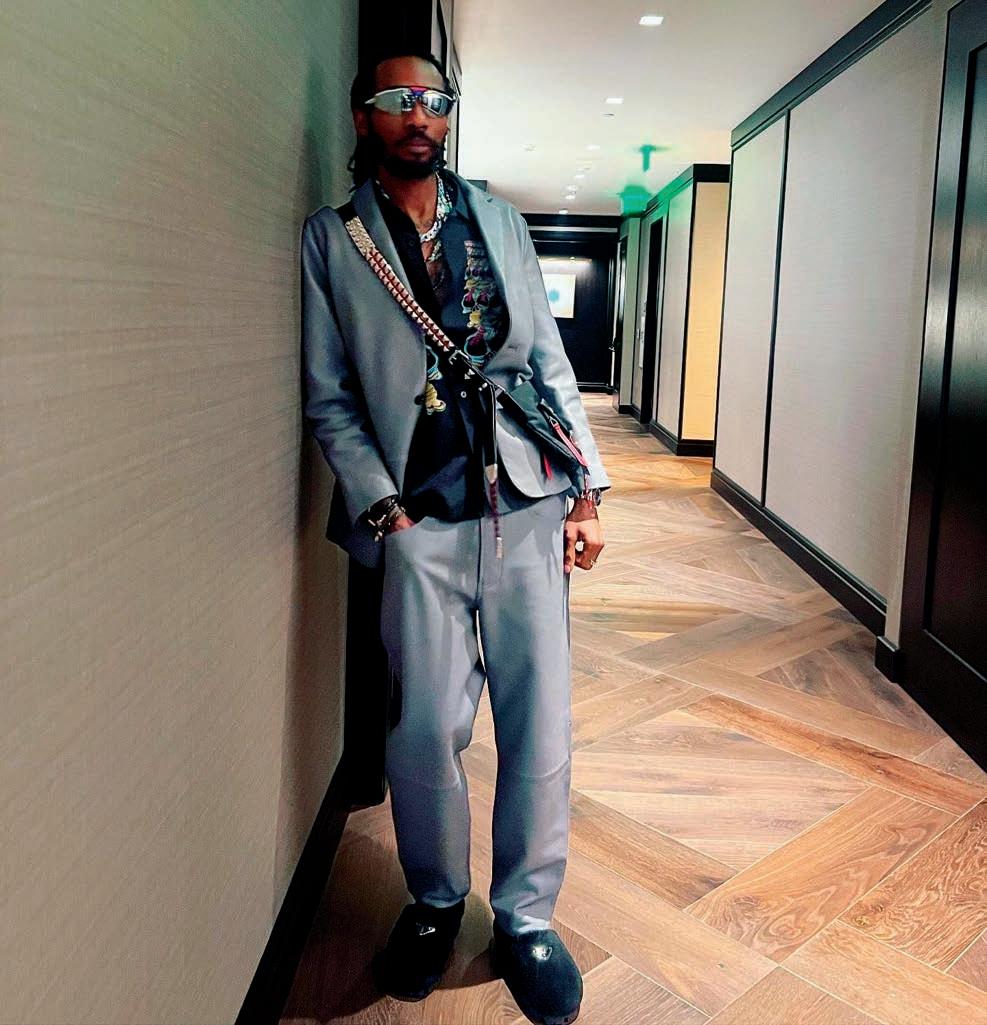 Photo courtesy of the artist
Photo courtesy of the artist
DP- Do you feel like you blossomed when you got here seven years ago? When do you feel like it took off,likeemotionally,withyourart?
When I came to America, it was because I really wasn't allowed or supported to be an artist. I always wanted to do more, and express myself because it gives me depth and the joy it creates. So when I got here, it was amazing the opportunities! It was mindblowing, you know, so I knew I could do anything I wanted to do if I set my mind to it and stick to it and give it time. So I was patient. And when I met my wife, Joanna, she was the one who really pushed me. She was the first major support I had, and being an artist like this; she is my everything. She saw it. It is such a nicefeeling,especially
when you have that female presence lifting you up. Even Michelle, and you, women are the core value of everything. Women have made everything possible, you know. So, having these people around me, I am veryverygrateful.
DP-Whatareyoulooking forward to?
MM-I want to be in a very good place. Where I can keep creating, and it's all I want to do, that keeps me happy, and that's everything to me. I want to make more sculptures and explore more places in the world, so I can gain more knowledge. I'd love a bigger studio, so I can just go wild and have no limits to whatever I do! It is all a goal,andeverygoalisagoalforourteam.

Since his days in Nigeria, he has been acutely aware of hisblessings.Heisnowafather,ahusband,andcreative. He is in tune with the invisible lure pulling him toward his destiny. Careful with his thoughts, Moyo yields virtue through his work. His energy is like a candle that accepts the wind and places the light perfectly. His canvases, contain both the past in the present and give something that will be left here, until next time. They are a humbling ode to where he evolved from, a deep thankfulness for where he is, and most importantly, enjoying his life, "knowing"thesearetheGoodOldDays!

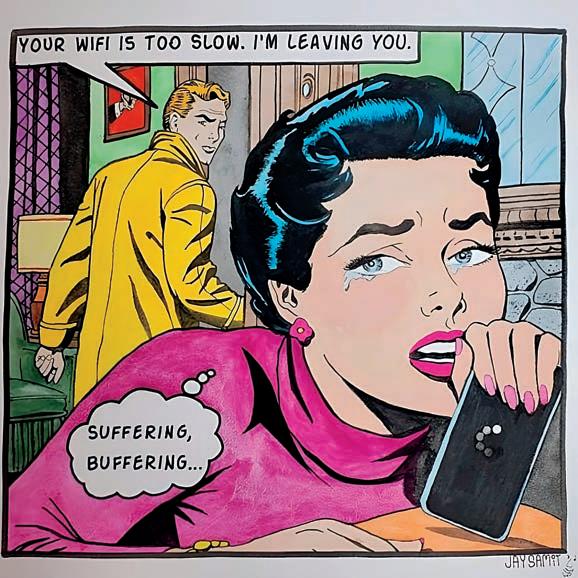
 Written By Albrecht Behmel
Written By Albrecht Behmel
In1968,whenAndyWarholproclaimedthat“in the future, everyone will be world-famous for 15 minutes”, he couldn’t have imagined a world where unplugging and becoming anonymous would become a luxury. We look at our phones before our feet touch the floor inthemorning,stareatscreensallday,have disembodied voices guide us through traffic, interactwithcorporatechatbotsonthephone and then curl-up at night with our tablets, TVs, and phones as our contestant companions.Facebook,Google,Tinder,Netflix, and Alexa now dominate the very lives they were intended to enhance. Beauty filters change how others see us and how we see ourselves. This dichotomy, the tension between technology and humanity, is explored in a fresh new way through the 50 paintings being exhibited at Jay Samit’s new solo show at the Richard Taittinger Gallery in NewYork.
In previewing Samit’s first post-pandemic show,oneimmediatelyconfrontstherealities ofmodernlife.Theinterplaybetweenfamiliar comic book imagery and penetrating text takesthevieweronadystopianjourneyofthe informationage.WherethePopArtmovement grew out of the optimism of and consumercentric culture of post-World War II England and America, Samit’s watercolors emerged from his own reflections of his forty-year career in technology and the new world he helpedcreate
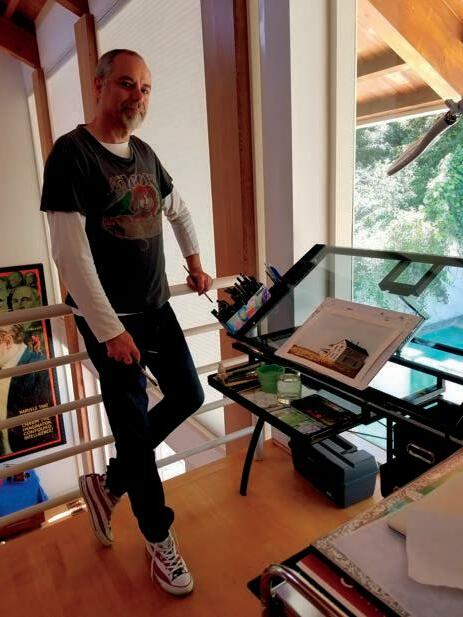
Samit was first exposed to the Internet while a student at UCLA in the 1970s and spent the following decades pioneering the very technologieswenowtakeforgranted.Hefirstput video on personal computers in the 1980s and built the first million-member college social network in the 1990s. At the dawn of the new millennia, Samit worked with the White House to get the Internet into every classroom in America. His hope was that the so called “information superhighway” would disseminate knowledge more broadly and equitably. He saw the Internet asatoolforprovidingequalaccesstoeducation globallyandmakingthepeopleoftheworldmore connected to each other. In senior management rolesatcompaniessuchasEMI,UniversalStudios, and Sony, he expanded entertainment’s reach around the world by creating download and streamingservices.Byallaccounts,Samitshould be looking fondly back at the body of his technological achievements, but to paraphrase Jurassic Park’s Dr. Ian Malcolm, “He was so preoccupied with whether he could do these things,thathedidn’tstoptothinkifheshould.”
ThepauseofthePandemicgaveSamittimeto meditateonthedarksideoftechnology.Hesaw however more powerful artificial intelligence wasenslavingus.Muchlikethefrogsthatdon’t jump out of the pot as it slowly begins to boil, we were so busy using the latest and greatest apps, we didn’t notice how our humanity was reaching its boiling point. Pop Culture is no longer a mass media shared experience, but rather an all too alienating private interaction between humans and their all too pervasive devices. Artificial Intelligence and algorithms manipulatehowwelive,love,work,andthink.AI influences whom we date, what we consume, andwatch,andevenwhatwebelievetobetrue. Our reality is an amalgamation of pixels. The promise of social media making us each more connected has been swiftly coopted to be engines for hate and divisiveness. Social media’spromiseofempoweringtheArabSpring has devolved into a monopolistic totalitarian tool. Advertising platforms that Samit built to engage are now used to target our vulnerabilitiesandexploitourinsecurities.

Artist Jim Dine exclaimed that Pop Art “is the American Dream, optimistic, generous and naïve.” The vibrant mass consumerism first exhibited at the Pasadena Art Museum in 1962, which showcased works by Andy Warhol and Roy Lichtenstein, is a launch pad for Samit’s unabashed art. Based in California, Samit’s work is influenced by fellow Los Angeles artists suchasEdRuscha,JoeGoode,PhillipHefferton, Wayne Thiebaud, and Robert Dowd. Whereas thePopArtfromhalfacenturyagohighlighted how the products of everyday lives had becomecommoditiestobeboughtandsold.
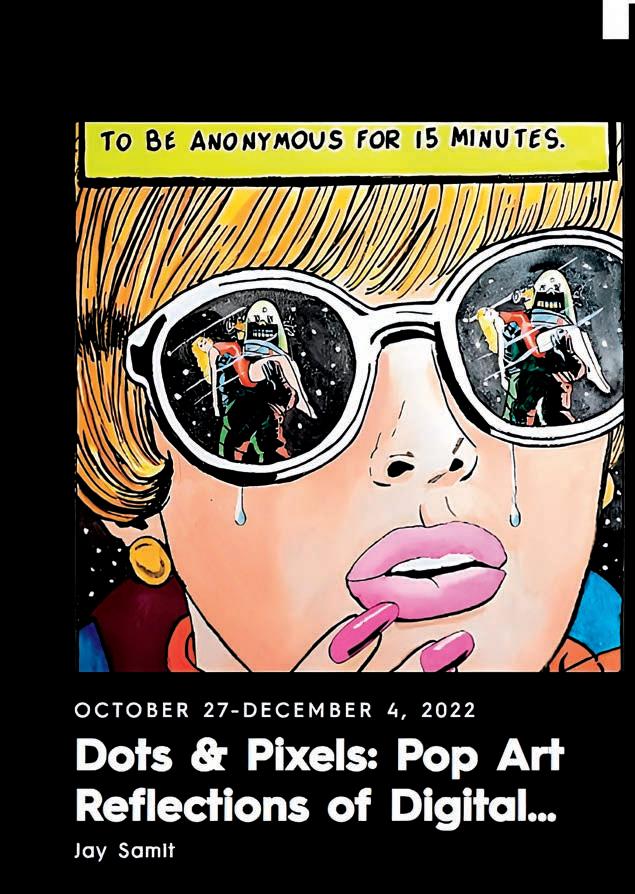
Samit’s collection of paintings shine the spotlight on how we have become commodities. Our lives reduced to pixels of data sold to the highest bidder millions of times every day. What further separates Samit’s art, and this exhibition in particular, from the traditional Pop Art movement is how personal eachpaintingfeels.Weidentifywiththefrustrations of screaming “representative” into the phone and relate to the woman who ponders, “I’m not sure if TinderisbrokenorI’mjustugly.”Thecenterpieceof the show is a bright 18” x 24” tryptic saturated in yellow, orange and magenta. Across three ever tightening close-ups, a woman cries out in agony, “Alexa,turnmyfeelingsoff.”
Oncewelookupfromourdevices,weseeourunvarnishedselves.Byexploringthevalueexchangeweallhave succumbedto:tradingprivacyforconvenience,intimacyforpopularity,andtrueconnectionsforlikes,Samit’sworks inviteusalltoreflectonwhatourliveshavebecomeandwhatwehavealllostalongtheway.
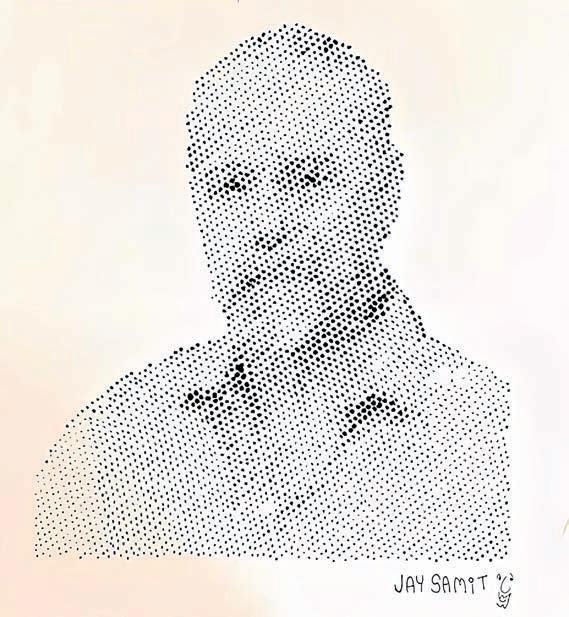
Samit’spaintingtechniqueofpreciselyconveyingtheaestheticoflastcentury’smass-producedcomicbookslures theviewerintoeachfamiliarvignetteonlytobeconfrontedbybitingtextthataltersthecontextoftheimagery.Each of Samit’s paintings have a poignancy that take us on this journey from past to present, from complacency to abhorrence,withawinkandanodthatwilloftenhaveyoulaughingoutloud.Thisexhibitionisalsoarunestonefor futurehistorianstobeabletolookatwhatlifewastrulylikeatthebeginningofthe21stcentury.
AllofSamit’swatercolorandgouacheworksarepaintedon140lb100%purecottonpaper.Paintingsrangein sizefrom12”x16”to18”x24”andarepricedfrom$5,000to$7,500.Dots&PixelsrunsnowthroughDecember 4thattheRichardTaittingerGalleryat154LudlowStreetNewYorkCity.
 Written by: DONNALYNN PATAKOS
Written by: DONNALYNN PATAKOS


The large industrial door suddenly squeaks open, abruptly drawing my attention to the two gloved men and a tiny forklift pulling inside the studio. I'm intrigued as they start unloading some pieces of Miami onto the studio floor. I am sitting with AlexandreDiophavingsometeaandlookingoverat the newfound local wares to be added to the piles of wooden palettes, leather straps, cloth, pieces of metal, paint bottles, and even palm tree stalks scatteredaround.PiecesofMiami.
I begin to imagine the destiny of that brightyellowBustellocoffeewrapper.Willit be someone's hat or pants, and what may have made him choose that? Perhaps the perfect bright color, yellow, captured his eye. All of it is a beautiful mishmash of possibilities. Found elements will soon find themselves as a piece of culture inside a frame—a transference of time wrapped up like a jewel box in a fantasy created by AlexandreDiop.Timeandskillwillsoonpull together something with such fantastical verve, making one covet what was thrown away. Diop is an expert weaver and storytellerspanningtime.
To describe him is like depicting his splendid creations, bright, layered, unexpected, with a profound message. He has a charming, gregarious demeanor, smile, and energy one can feel in a room before seeing him—he radiatesagraciousdynamism.
His art is enmeshed with narratives, dispatching both good and dire auguries. Agile, flowing outpourings of messages with characters being the observed or the observer, perhaps pensive and occasionally machiavellian. His art is filled with the energy of society from the things he places in it. He firmly believes that the scenes are his social responsibilitytohisviewer.

The way he pieces it all together is layered both mentally and physically. It is more than just repurposing to create something pretty. The objects become part of the saga or truth henarrates.
After interviewing him, I considered how to relate his ability to elicit the pull and response from people with his talent. How to describe thattypeofessence?
Would it be the same answer for every great artist? Alexandre has a story to impart. Moreover, he has a stormy, fierce intent. Via hisart,heiscognizantthatheisamessenger, which is a great responsibility. There is a deep awarenessofintegrityasacatalyst.
Iwasoncetoldastorydescribingintegrity. One definition of integrity is something wholeorcomplete.
The found things are given integrity by Alexandre's careful placement and message, What comes to life are reflections of society, intently puzzled together. His stories, jab the wooden stick in the spokes of a poorly running bicycle calledsociety, wherepeoplearebeing

misled, lied to, as they endeavor to move forward.
His words are critical to his illustrated tales inspiring him to wake the viewer to the mass deflection given to them by a small group of people coercing them to actandthinkacertainway.
He is documenting a genre, a stamp in time, revealing the public sentiment of a placehehasbeenbuthasnotleftbehind.
DP- How did you start adding these elements to your work?
AD- Once, I was so frustrated that I decided to cover a painting with a piece of paper and thought, this could be a solution; what I cannot do with my fingers, I can find something and mix things. I thought I was not made for painting; maybe I was made for sculpture. But then found thissolution

DP Talk to me about the importance of connectivity between the creative and the magnetic pull of work. How do you achieve it?
AD- Some artists do not make it personal, and some artists do. However, it is a commitment you need to build trust with your public as an image maker. You need people to have enough time to go and watch your pictures, take them in, and understand them. It is also important not to consider any academics or story to be aware of the people surrounding you and to whom you wanttospeak. Anartistisnotjustcreative.Theyhaveastrategy within a society. They need to organize themselves to go as close as possible to their objective, which is to bring new possibilities of thinking. Is there a separation between the artist and the artwork? I think not. It is an extension. There is a piece of a person there. If it is not personal, it is not easy to relate to it. An artist is not only creative but aims to bring as many possibilities as imaginable. We do not need artists that repeat the manifesto of others. Why? Onecanonlyaskforfoodifonebringssomething new to the table. Do not ask for a plate if you are just here to consume. If it is about your ego, you candosomething,butisitalreadydone?Itcould be more interesting. This is where it becomes difficult; it takes work. Like in sports and politics, youcannotmesswiththeresponsibilityyouhave. This is a lifestyle, and it is why you can recognize fast an artist living his art and can deliver, but when you see the artist, it does not seem real, andthereisaproblem.Thereisadisconnect.
 Photo courtesy of Portray Magazine
Photo courtesy of Portray Magazine
 Photo courtesy of the Artist
Photo courtesy of the Artist
 Photo courtesy of the Artist
Photo courtesy of the Artist
Photo courtesy of the Artist
Photo courtesy of the Artist
DP- You have a genuine connection to the social environment.
AD- I always try to be an influence in my society. I didn't want to follow the rules blindly but to associate with mine. As a kid, I realized there were many things to respect, but other things I did not find necessary, so I saw art as a tool. When I grew up, I saw these musicians, these writers that would write of freedom and emancipation of self and understanding of your own life. So, to be an artist was the only way to live life. I always knew I wanted to be an artist. I did theatre when I was younger, then moved to sports, but the sport was a gametoplay.ThenIstudieddance.Afterthat, I was a musician. I made electronic hip-hop music with synthesizer and drum mashings. Music is also present in my life, but art was always a tool to enjoy, express, go into a trance, or experience another kind of life. It is atooltonavigateandgofurther,togrowasa man, and to be in discussion with my surroundings.
DP-What was the first big canvas? Do you remember that moment, and what made you do it?

AD-Thefirstcanvasonwoodwasaboutthree years ago. I was already painting, and then I found this technique with objects. I was working with a wooden board I would find in the streets. I still like working on wood because it is a certain frame and context. Then one day in Berlin, a friend called me and said, Hey Alex, there is this big studio I think will be perfect for you. So I went to find the studio and organized myself, saving some moneyontheside.
DP-You said you played Football. Where?
AD- In France, I was a professional footballer and made the selection for the french team. I was good enough to play on a professional level. With life, I shifted away from it because I discovered dance; to be a professional, you need to respect many things. So contemporary dance, and conceptualdance,IwenttotheUniversityofKunst in Berlin. They have a bachelor's program, so I did that. Then I started painting and moved to The AcademyofFineartsinVienna.
DP- Do you dance and perform music when you have an opening? Do you like to create more of an experience?
AD-Iliketocreateaculture,avibeto bringarapperorawriterfromthe undergroundscene.Ihaveacollective calledtheBlackSheep,tryingtopromote outsidersindifferentGenrestocreate differentexperiences.Mypaintingsarea tooltocreateavibewithanadventure, sothedayweshow,Iliketohavemusic aroundacertainatmosphere,lighting, andparticularpresentation.Itshouldbe morethanjustadecorativething.

DP-You grew up in Paris?
AD- My father is from Senegal, and my grandfather was German. So I lived in Paris until I was 18, then moved to Berlin for six years,andthentoViennatwoyearsago. You give your work much respect. It's obvious. Things are carefully and lovingly placed, and there are many objects to consider, big and small.
DP-So how do you decide what is going to go where? Does it just come to you?
AD-It'slikecooking;youlearnfromexperience. If you put something here, you must put somethingelsethere.SoIputyellow,Iputred, and it's like a game. It is definitely like doing a puzzle.
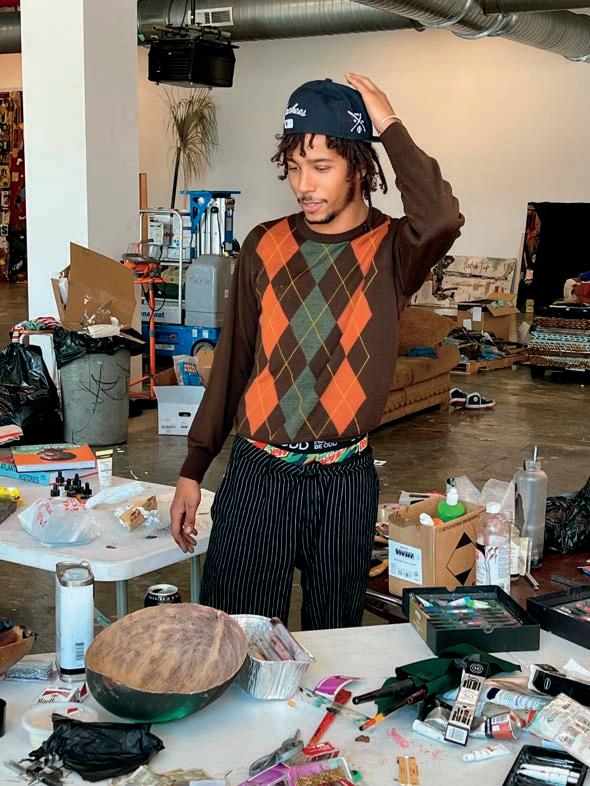
AD- To give new power to minorities and change the disposition of people holding the decisions of the people in our society toreshapethevalues. To rethink the democratic way of arguing with elites and stop being manipulated because I think we are manipulated every day by a small minority of people. Nowadays,youneedmoneyoradiploma to get respected. It should not be like that. We all deserve equality and to be respectedforthat,especiallywomenand children, and people of color, disabled people. There are so many things to improve in this society, so it is problematic that an artist pretends everything is good. No, If you are an artist, there are many things to fix, improve, and maybe rethink. We need people like me to advance and to go there and make people understand. There may be things people will realize through art because this may be one of the only possible fields. However, it is also a speculative field. Artists should be careful to keep this topic from being used because the bigger you become, the more you can separate from your originalpath.
My mother is white with Blue eyes. My father is black-with brown eyes, and voila! My parents never saw the color. If they did, they would not be together. We should be kept from being manipulated. These people are trying to tell you you are black, you are Chinese, you are a communist or capitalist. Whatever you are, you can respect others and think what you want. Still, you can also believe we are all from the same family anyway, whichisareality.Thereisnoonetruth.
DP- You're very deep; where did you think that comes from? Depth within ourselves is through events that let us reflect.
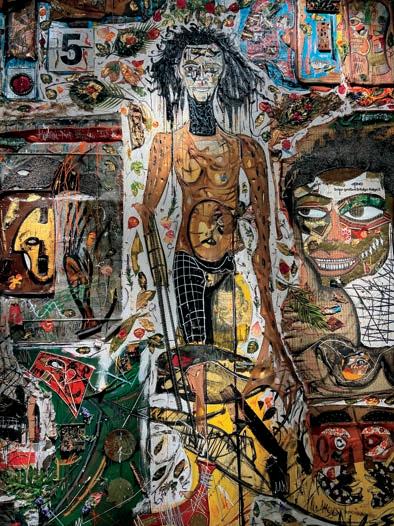
AD- I had the chance to have wonderful parents who educated me inthebestwaypossible.Mymotheris a social worker, and my father is a filmmaker. Both of my parents come fromquitehumbleenvironments. My grandparents were butchers on my mother's side, and my father camefromafishfamilyinSenegal. So when I grew up in Paris, I traveled a lot and have seen a lot in my life. I have seen birth, I had a friend who died very young, but I always had everything I wanted in my life. I have alittlebrother.Itisaprivilegeofgood people around you. You know, in minority culture, there is a lack. Peoplework,theparentswork,thereis a lack of education, and there is no support.Ofcourse,thesepeopleneed togetthisdepth.Ihavethechanceto meet really interesting people every day. Voila, it allows me to be curious andhumbleinacertainway.Ibelieve in humility even if I have a big ambitionandabigmouthandcanbe arrogant. I believe in respecting elders. There is a difference between someone seventy years old and a twenty-six.Apersonwhoistwenty-six should respect and listen. That is how Igotraised.
It is important to give young people respectsotheycangrowupwiththat confidence and give that in return. Respectisareflectionofone'sself.
"It is important to give young people respect so they can grow up with that confidence and give that in return. Respect is a reflection of one's self."
DP- You do not define anyone, but you define yourself by how you treat others.
AD- Yes, it's what my father always told me. It's important to respect yourself to respect others. For example, he would not let me go dressed a certain way, and I would ask him why, and he wouldsay,Becauseyouaremyson,respectme (laughing);respectyourself!
Alexandre gives his work much respect. It's obvious. Things are carefully and lovingly placed, and there are many objectstoconsider,bigandsmall.

He told me something that has entered my thoughts a dozen times since. "You need to follow the wind, catch a wind from God- to create destiny, and be aware to go this way, or that way when you feel it," describing how he got to where he is.
Alexandre's story, craftwork, and sincere intention communicate the messages entwined through creations and life. It has become apparent that a star has arrived.
 Photo courtesy of the artist and L21 Gallery 51
Photo courtesy of the artist and L21 Gallery 51
Brightflowers,fruit,warriors,nailsandlips,andwitchesareall amongsomeelementsconformingtotheexpressionofselficonsencounteredinFatimadeJuan'spaintings.Beyondher badass creations lies an artist that has had to earn her way to success at every stage. Coming from the island of Mallorca,Spain,FatimadeJuanbeganherpathwithgraffiti. She found a sense of belonging in the expression of it. Attractedbytheculturalundergroundandthealmostsecret language graffiti culture has, her passion for self-expression wasborn.
From the start, finding avenues to express her inner voice waschallenging.Shehadtofightthroughmanyofthemaledominated "machismo" to be accepted in street culture. Fatima says, "The graffiti world is very territorial; conflict arises when a woman uses manners and techniques of doingthingsthatbelongtoamalecollective."Thedifficulties she faced in this environment became one of the sources of the splendid sassiness uncovered in her paintings' heroines. Defending her creative endeavors also made her somewhat defensive, but also, thankfully, gave her an edge in knowing howtostandupforherselfandpursueherdreamsandpath, no matter the difficulty or opposition. Sometimes there was oppositionfromherfamily,whodidnotwhollyapproveofher doinggraffiti.
Initially, graffiti enticed her due to the large format and the freedomtogotoawallandexpressherselfwithouthavingto answer anyone or ask permission. Sometimes the gratificationwaswritinghernameonawall,whichwasmore profoundthanspraypaint'sartisticorvisualmeaning.Itwas the common language that united her with the graffiti culture.


As fate would have it, she would eventually take a break from graffiti and find her love for painting on canvas to explore new feelings. This love originated organically. Oscar Florit, a respected gallerist from Mallorca and Director/ownerofL21Gallery,reachedouttoherafterhesaw an Instagram story she posted. In the story, she was spray painting under a bridge, and Oscar asked, "How come you don't paint this in a large format on canvas? Why don't you try it?" There were no meetings, long talks, or business agreements,justsuggestions.

Fatimawasn'tgettingtherushorchallengefromgraffitishe oncehad.However,thenewchallengeofattemptinglargescaleartenticedher,whichevolvedintoanewmountainto conquer. "I had many emotions similar to when I began doing graffiti. The point at which you lose control and experiment. It gives you a bit of fear that perhaps you are doing it wrong, but at the same time, it's exciting. It makes youfeelalive."
It caught my attention how open she was to explore a suggestionfromastranger,perhapsitwastheapproachor the right moment, but not many artists take kindly to requests. I asked her to elaborate on this, and her response was,"Myegoisn'tsobig.Iacceptmore.Itislikethewarriorin mewholikesfightingformythings.Iwondered,whatifIgive italltofightforsomethingnewthatcantakemetodifferent roads? I find that beautiful. The fact that you can live in one lifetime,manydifferentkindsoflives,isincredible.Youcould bedoingsomethingyoulove,butyoupickeverythingupand dosomethingdifferentoneday.
"I WONDERED, WHAT IF I GIVE IT ALL TO FIGHT FOR SOMETHING NEW THAT CAN TAKE ME TO DIFFERENT ROADS?"Photo courtesy of the artist and L21 Gallery
The inspiration in her paintings always begins with women, delivering a voice to the inner child giving shape to that idea of what she describes as "Amazonian women" with large size, gigantic proportions, healthy, empowered, strong women. Paintings that are sometimes sweet, sometimes sassy, and sometimes more warrior-like. She paints warriors because it is her way of conveying power and strength to her inner voice, her inner child. Growing up, one of her favorite tv characters was XenatheWarriorPrincess,whichshealsoadoptedas herstreetname.Alloftheaspectsthatliveinsideher, sheexpressesinawaytostrengthenherself.
Over the years, she allowed herself to merge sweetness, kindness, and maternal instincts in her works. However, she did not permit herself to explore this at the start of her art. She did not allow herself to cast a more delicate side as she does today. In the primarily male-dominated street art crowd, she felt like she could have used a mentor to give her guidance which was frustrating for her early on because she found no one willing to provide her with thetimeofdayregardinghervocation.Also,thesocial context in which she was born invalidated her search for a path in art. Fatima commented, "Earlier, I only validated to make myself stronger. Today I realize no fight needs to be had in being relaxed. In tenderness, there also are many things one can explore, even thoughtheyaremoreintrospective."
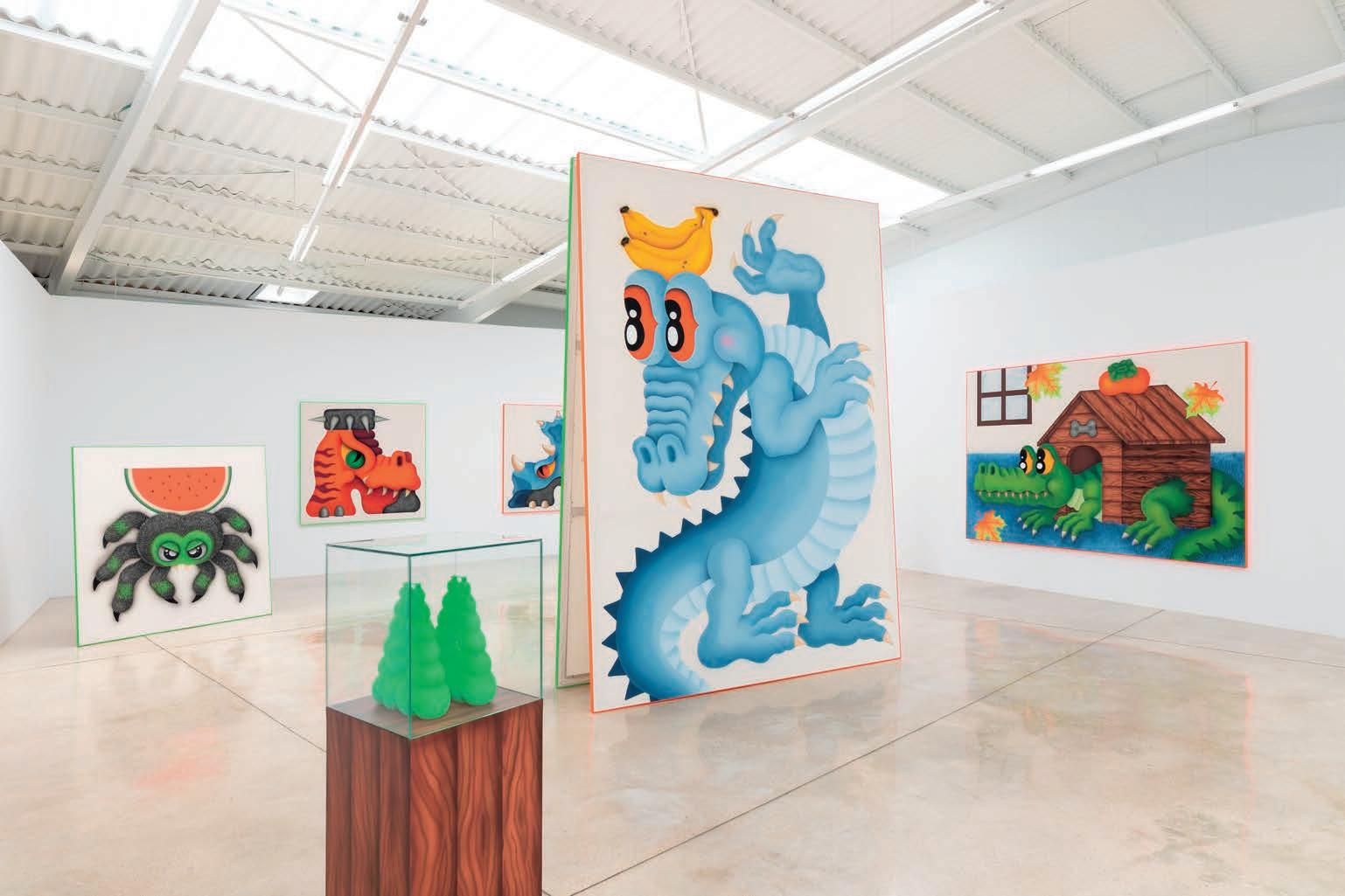
"Iwouldimagineabitofawitch,abitofawarrior,andabitof attitude,eventhoughitcameunconsciously,Iforgedwiththeyears tostrengthenmyself.Itisasifitwasagoddessthatyoupaintto nourishyourself.SothereisanexchangeofenergywiththatwhichI paint."

"I find sweetness to be a superpower that is often overlooked.Attimessweetnesscanbethatenergythat makes people feel comfortable or safe. Sometimes maternalinstinctwomenhave,bringsdownthewallsin people.Attimes,somewomenfacefindingthebalance between being sweet and not letting others take advantage of that. Favor that sweet side but embrace thesalty."
The fact that she had a studio in which to work allowed her to live painting in a more positive, centered way than on the street. Also, with age comes wisdom, and she has found an equilibrium between the two halves that are distinctive parts of her being, parts that today go in parallel without competing against each other.
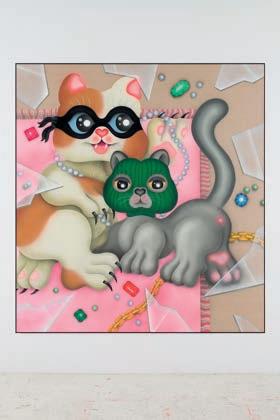
"I FIND SWEETNESS TO BE A SUPERPOWER THAT IS OFTEN OVERLOOKED."Photo courtesy of the artist and L21 Gallery

Fátimahasfoundthatbalanceinherart.Throughtheyearsandexperiences,shefoundaway toexpressinherpaintingsalltheemotionsshefeelsthroughexcitingheroinestorelatetoand from which we can all take something. She forged a way where there was none, owning somethinginsideherthatshecouldn'thelpbutletoutandexpressthroughherwork.
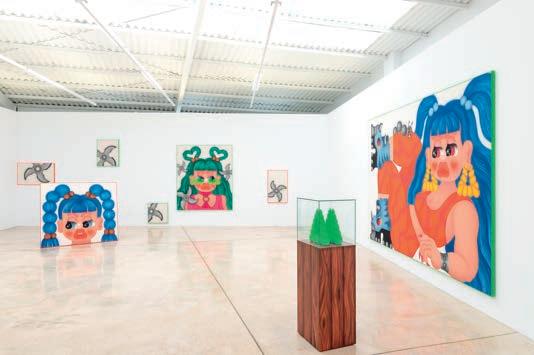
Her family is still a bit tentative; they still don't understand her choice of art but are proud. Fatimafeels,"Whenyouescapethehamsterwheel,everyoneseesdanger,butIlookbackand seethehamsterwheel."
She is grateful for the good she has and considers herself fortunate to know someone at the beginning of her career who supported her in pursuing her dreams full-time and offered to sustainhereventhoughmoneywasscarce.Toher,thiswasoneofthemostbeautifulgiftsshe hadeverreceived.
Receiving advice at the right time from a person that had no prejudice in giving her an opportunity, especially since she was not part of contemporary art, was another gift she cherishes. Fátima occasionally does graffiti in her spare time, but she does not publish it becauseit'sonlyforher.Instead,it'slikehertimeforawalkintheparktoblowoffsteam.
PM-Whatmadeyouleavetheworldofpublicityand muralstodedicateyourselffull-timetotheartworkon canvas?
FD-Advertising and graphic design were just a job. But painting was always my vocation. It's something innate that you do without thinking and pretension. I made my way with mural painting since I came from graffiti; it was the most immediate path. Then the opportunity to paint on canvas came up; for me, it was a rebirth.
PM-YousayyoufoundinspirationinyourtriptoCuba. Whatabouttheircultureandwayofunderstandinglife madesuchanimpressiononyou?
FD- The simple life, its old and colorful houses, and the generosity of its people. I love its culture, music, and ability to live in the present.
PM-Areyourpaintingsareflectionoffeelingsfromyour pastthatyouareexpressingormoreimmediate emotions?
FD- It's both. It depends on the day, what I'm thinking and how I feel. Sometimes you fight with a painting. Sometimes, you cuddle it like a baby. (laughs)
PM-Wheredoesthesassinesscomefrominyour paintings?
FD- It is a mix of everything that I like or defines me. My characters are sensual, brutes, amazons, tender, warriors, and even a bit childish, I am all that, and they are babies that come from within me.
PM-Whattookyoutograffitipainting?
FD- The freedom to paint in the street and fulfill the need to express me, have fun, and do funky stuff. I've always been fascinated by large formats, appropriating public space, making it your own, and painting it without anyone's permission or approval.
PM-What'sbeenthemostrewardingthingforyouinyour career?
FD- My exhibition "Pretty Thug" at L21 marked a before and after.
PM- Did you keep the process of that light, quick movementingraffitionthecanvasnow?
FD- The codes are different, and each format has its demands. Even so, many things are inherited from graffiti, the dimensions, textures, finishes, and painting with the whole body.
PM- How much of what you make on the Ipad or paper makes it to the canvas? Does it evolve further once you getstartedonthecanvas?
FD- I draw on paper. Then I use an iPad to give four spots of color and make tests that only coincide a little with the final result. It is an idea, a sketch, and I like to start painting and let the work suggest colors and shapes beyond the initial idea.
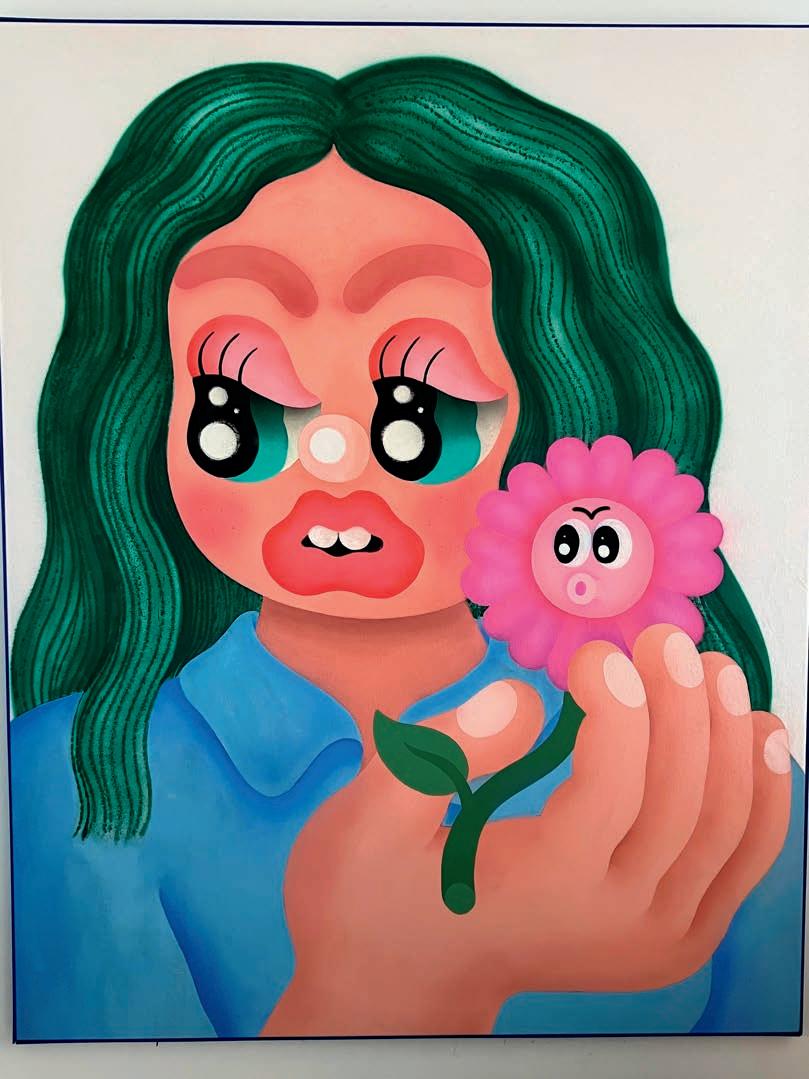
PM-You'vebeenabletodefineyourstyle.Whatcouldbe yournextevolutionasanartistorperson?
FD- I believe that style constantly evolves and is linked to your evolution as a person, to the moment, and your feelings. So despite my style, I want to reinvent myself, contradict myself a thousand times, and still be me
PM-Whatwouldyoutellthenewgenerationofwomenor youngartistswhofindinspirationinyou?
FD- To fight for their dreams and not allow anyone to tell them they can't. If you can overcome that, you can overcome anything. Ignore what others think. Ultimately, it has to make sense to you, and you push your idea forward. To have fun with their work and that we women are the future.

Please pull up a seat and let me transport you across a canvas. Let’s follow a whirling dervish of intensity dance within the shadows, bask in frothy shades, leap in the light,andfeelaspiriteddisplayofcoloronfull tiltcreatedonacanvasbyAlexanderYulish. Experience how he can create a lyrical whimsythatbeckonsconversation!
There is a curious toggling of discovery and reflection within splashes of colors and patterns that reveal both the artist andhispainted,enchantedworld.

There are stony stares and an eye you can’t catch
Embellished boots and jackets that match Swaying bodies ablaze with color and Proximal doors leading into each other Ducking from the world or are they just bored?
Expecting someone or being ignored? More than mere figures, they have their own tribe
Bothersome, or buddies it’s hard to describe Linger if you want; they don’t mind you are there
You’ll most likely spot them when you look everywhere They Frolick around as stillness on display and I don’t think he’d have it any other way
First and foremost, I love how there is no certaintyabouttimeorplaceinhispaintings. Andthecolors!
Bigblues,taffetapinks,oranges(anewcolor for him in his works this year), and texturing brings a feeling of deep exhalation and heightened sensitivity imparted freely and intuitively in and around the paintings. At times, silkscreen will be wrinkled or not fully attached, giving a voyeuristic eye a temptation to peek at what is below it and see what is being covered in the shade. Yulish can shift shapes and collage into intricate color alliances, unveil biomorphic figures with a rich and unique balance of sway and strife over the canvas, creating a lyricalwhimsythatbeckonsconversation!
“These colors, they decimate. That’s why we do what we do!”
DP-Therearethesestrokesinyourwork.Isitafanbrush?
AY- No, it’s a technique I have; the way I move the brush, it’s a mood, and it’s intense. There’s a release while it’s happening that I can’t explain, but I enjoy it!
Yulish will Invade harmony with an instinctive sassiness, like placing a cerulean fanned-out slash on the bias across the entire canvas, happily bringing Tobasco to his tea party to spice things up. (Add that to your finger sandwich!) When you know him, you know when he does this; it just felt right to him. It began where it began, and it ended where it did, and if it was directly over the whole composition, so be it!
One can almost overhear his thoughts and sense his pleasure as he ruffles feathers because he understands it’s often the scratch on a vinyl record that makes you listen more intently, heightening the experience.
Alexander Yulish has the energy you want to bottle. He is a sensitive, effervescent good finder with a wicked sense of merriment, creating works that pulse with color and sing with magical spectacle, captivating the viewer with equal parts charisma, relatability, and surprise.
Growing up in New York City, he shared time between living with his father, who worked in PR, and his mother, a well-esteemed artist, illustrator, and sculptor, Barbara Pearlman. He was immersed in an art-centric environment, watching his mother paint for hours in her studio. His parents provided and encouraged a creative setting for him to develop his artistic path by example. He accredits his mother for being the one to foster his technique and teach him to be true to his process.

DP- Do you go to work every day?
AY- When I was upstate for 3.5 months, I would go every day. I have a studio on my property. Right now, my studio is in NJ. I’ll work Mon-Fri- I don’t wait for inspiration to paint, then you sit aroundwaitingforever.

DP- Did you read my article on Chuck Close, when he said, “Inspiration is for Amateurs”?
AY-Ilovethat!Whohastheballstosaythatinthe art world? I have to hear about inspiration all day long. Something always happens when you just do the work. Inspiration is a misconception; people think artists, they get their coffee, they paint a little… No, it’s brutal, man! The more you paint, the more you push. It’s like you’re driving a car,andyouwanttotakethatcarandburnoutthe engine. You want a wheel to fall off! That’s what it is like, at least for me. I want to be shaking by the end of it. I want my hand to be exhausted. There is a point, if you get too tired, you get sloppy, and youhavetostop.
DP- Tell me about finding yourself in the process.
AY- I was watching a movie, and in it, someone said, “Your narcissism is so mediocre” I thought it was one of the funniest things I’ve ever heard – I don’t even know how I arrived at that, but I try to laughatmyselfalotandfindhumorinit.Ithinkmy artwork is not original. My artwork is the human condition.
DP- How do you even explain that unless you feel it yourself? Of course, it’s unique.
AY- This is a conversation that no one has had before. Isn’t this the first conversation? You enlightened me, and perhaps you changed my mind; that’s a conversation. That’s exciting! Why be stuck in your ways? To me, that’s boring. It’s like saying I eat sushi all the time, and I can’t wait to share it with you. These colors they decimate. That’swhywedowhatwedo!
What is the name of this painting? I asked one day on the phone while we were looking at some of his paintings.
AY- “You interpret the story the way you want to interpretthestory.Iamheretogiveittoyou.”was his response. After carefully observing, I laughed and said, ” It looks like there’s there’s a monkey in the Disco booth,” and that’s what it’s called now. He told me that he doesn’t like to title all of his paintings, as he leaves it up to the viewer to interpret it the way they experience it. It’s more funforhim,andthisishowthisonecametobe. Whilevisitinghiminhisstudio, Hethoughtfullyhad the Monkey in the Disco booth, waiting for me on oneofthewalls.
 Photo courtesy of Portray Magazine
Photo courtesy of Portray Magazine
What’s apparent immediately in the studio is his warmth. There are large windows, tall ceilings, and it’s a good thing because a) He is tall and b) He prefers to paint large-scale. He carries around his canvases effortlessly, hanging them up with a big smile, completely engrossing us withhisexplanationsoftheworks.

DP- How big do you go?
AY- The Largest was 20′ x 18′. I’ve done a 7′ x 13′. I like to do 6.5′ x 6.5′ or 8′ x 10′. I like 4.5′ x 4.5′.Thesmalleronesareevenmorecomplex!
DP- Do you feel confined when you go to a smaller size?
AY- I do! It’s compressed, just getting it in that conversation and saying, you know what? You will have to say everything in 20 words, not 1000 words, and it better be just as clear and just as precise. It’s really difficult at times, but I’m so relieved when I feel like there is work that works! Sometimes, you throw them out and never want anyone to see them, and sometimes you leave it, and others you go back to a month later, and you think, what the hell was I thinking? And there are some you just love, and you don’t wanttopaintover.
DP- Have you ever done work, put it on the side because you weren’t feeling it, go back later, and think, this is amazing! What was I thinking?
AY- Yes, I have felt that! It’s so funny when you say to yourself, “Oh, it’s amazing, it’s so good, this is a home run”, and someone just walks by and doesn’t even look at it for two seconds, it doesn’t evenresonatewiththem.
I remember being at one of my shows. I looked over and saw someone and it looked like they literally got punched in the stomach when they were looking at a painting. I was like, “Oh God!” and I was so happy they really emotionally felt it. Then I literally saw someone else look at it for like a second, look at their cell phone, walk around the show, look at their cell phone and leave. (laughs)
Sometimes, it takes you a little time to understand something, and those are my favorites, and other times things have to be incredibly visceral. It’s like how you approach life, you know like sometimes you listen to a piece of music. When I listen to jazz, it’s very uncomfortable for me; it’s almost too much how I feel, the disjoints the ups and downs. It can be toopersonal.
If you listen to it, the soundtrack of my life would be mixing with the same thing, and you will have that rage, for three seconds, then soothing, then bouncebackagain.
DP- I think people can be psychoanalyzed by their playlists!
AY-Absolutely!
DP- How do you feel about sharing your work? AY- I like sharing my work. In the beginning, I was scared when someone bought a piece, but now I just think they get to go home to someone, and they appreciateit.Itbecomespartoftheirfamilyandpartof their life. Someone comes home to it, and it greets them. That’s exciting. It really is! They look at my art, and I say hello to them all the time. It’s like a present yougiveeveryday.
Alexanderisalsoskillfulatescortingtheeyearoundhis narrative, allowing him to communicate an intimate dialogue tactfully, creating a thoughtfully crafted connectionwiththeobserver.
Perhaps it could be some familial objects in his works. Some examples are doors, lamps, tables, windows, and figures seated with hats and embellished boots. There may be a feeling of restlessness or, perhaps waiting,orboredom.
DP- How do you feel moving forward, with all the new colors?
AY- I’m really scared because I feel like I’m risking something and trying to push it; it may break to pieces, and it may move forward. I want to be able to go to that edge and not know if I’m going to fall down to the rocks. I feel like I’m talking deep down inside to that persontochange,pushit,andtakerisks.
Keith Greenbaum StudioI liked so many of his works but felt pulled to one inparticular.Thesubjectlookedlikehewantedto go someplace, so I ultimately brought it home. The figure would not look at me, so I gave him a view. He now stares out the window in my living room. His mouth pursed, twiddling his knobby fingers, leaning forward in his seat as if he was about to stand. One foot on the ground and one perhaps resting on a bar on the chair. There is an impatienceandyetawarmthcomingthroughthe window, traveling down throughout the canvas, possibly keeping him there, and my favorite part isheisn’talone.
Sometimes, there is a secondary script playing beyond what you initially see in Yulish’s paintings. An assemblage of misfit figures, perhaps ignored on the fridge growing up, who have resurfaced in snarky bunches in and around the works. I have come to call them “Yuligans.”They can be mayhem makers, creating a commotion, or perhaps outside a window looking in longingly in one of his timeless realities. They appear under tables, in the windows, slithering up lamps, munching on wires. Hidden in plain sight, once noticed, the pesky or lovable little creatures fight for your attention, demanding their due time in thespotlight.


He has been painting since he was around six and began painting fulltime in his thirties, and like anything he puts his energy into, it bloomed. Quickly catching mega collectors' and art critics’ attention, his work has been on exhibit in galleries in New York and Los Angeles and is in the MuseoJumex,Mexico.

DP- I heard your work is in Eugenio López’s collection at Museo Jumex.
AY- He is a very good patron. He is a champion of the works. He discovered my work in my first show. I was in Los Angeles in a place called Gallery Brown. I remember, “Breakdancers of NY.” It was a smaller work,Ireallylikedit,andIguesshelikeditalottoo.Whenpeoplelivetheir lifeforart,thereisacamaraderiethathappens,andit’slike,lookwhatyou have done. When someone is as interested and appreciates something youdo,there’safeelingofwejustsilentlyjustshookhands.
AY- I do! I collect other artists too. If the work really speaks to you, they are making you have a better life. My life is better because if you have one of my works, you feel better every time you walk into your home. I haveotherartists’workinmyhouse.IjustputupanEddieMartinezinmy home.
DP- Have you ever sculpted? For some reason, I feel like you have a connection to sculpting, or perhaps will. I don’t know why?
AY- My mom is a sculptor, she is unbelievable, oh my God! It’s like a hybrid.It’sherownlanguage.I’mexcitedtotrythat.
DP- Something in me thinks that you would be really good at that.
AP-Itcouldbesomething,yes,Icoulddoit,whenthetimeisright.
One of the highlights of my year has been meeting and getting to know him personally. I look forward to our spirited, happy conversations mixed with reflection, appreciation, humor, imagination, and ideas! He has an unwavering optimism, despite what may be occurring in the world. He is likeasparkler,makinganyoccasionthatmuchmorespecial.
www.namastate.com


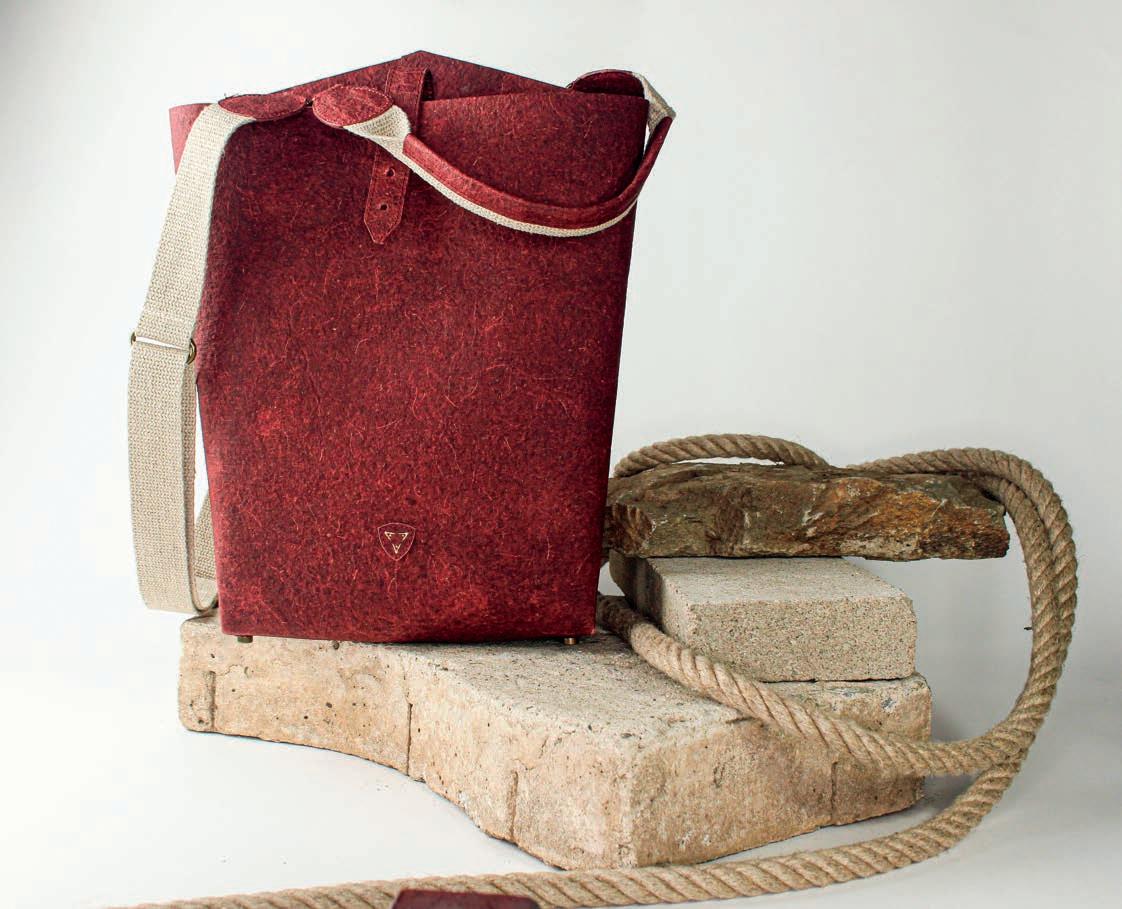

Critical thinking may begin with an objection formed in a debate deep within our mind. As we see life and expand, so does our belief system. This harvested sentiment nurtures us, protects us, and even defines us. But how do we identify and relate to one origin when our own is multicultural? Do we wake up one day feeling more defined by our birthplace, genre, sexual orientation, religion, political affiliations, peers, or work? There is a slight disconnect as the fragments of one culture clash with our upbringing. For those of us living in America with multicultural backgrounds, it's easy to feel like, "We're not from here, and we're not from there." So how do we open our minds, our beliefs, and our eyes to appreciating and accepting the different roads that lead to one common path we all tend to seek? The feeling of belonging,appreciation,andlove.
Jose Zuniga explores the multicultural contradiction of being born in America with a Mexican backdrop. His pictures are, at moments, characters from his past, rearranged to depict the internal scrabble of endeavoring to define the search for a feeling of belonging without feeling, as he says, "That you've been deported twice. " He further underscores this by stating, "As soon as a Chicano artist tries to become an American artist, they're directed to the Latin American table. But then the Latin Americans are like, well, you're not Latin American, you're American." This misplacement has guided him to observe life and search for a new way to communicate that may be misunderstood and not perceived by those who speak a different cultural language.


This search began early in his career while he was attending Columbia University. At the time, he was not receiving much praise from his teachers and mentors. His art was too focused on representing and referencing Chicano culture. Feeling prejudice in art school, Zuniga confides, "I had to switch, I had to turn that off, and basically tell them the same thing. But I was using Bauhaus aesthetics, using modernism aesthetics to talk about the same story. I guess there was a language conflict. I was speaking too much Spanish, and they didn't understand it."

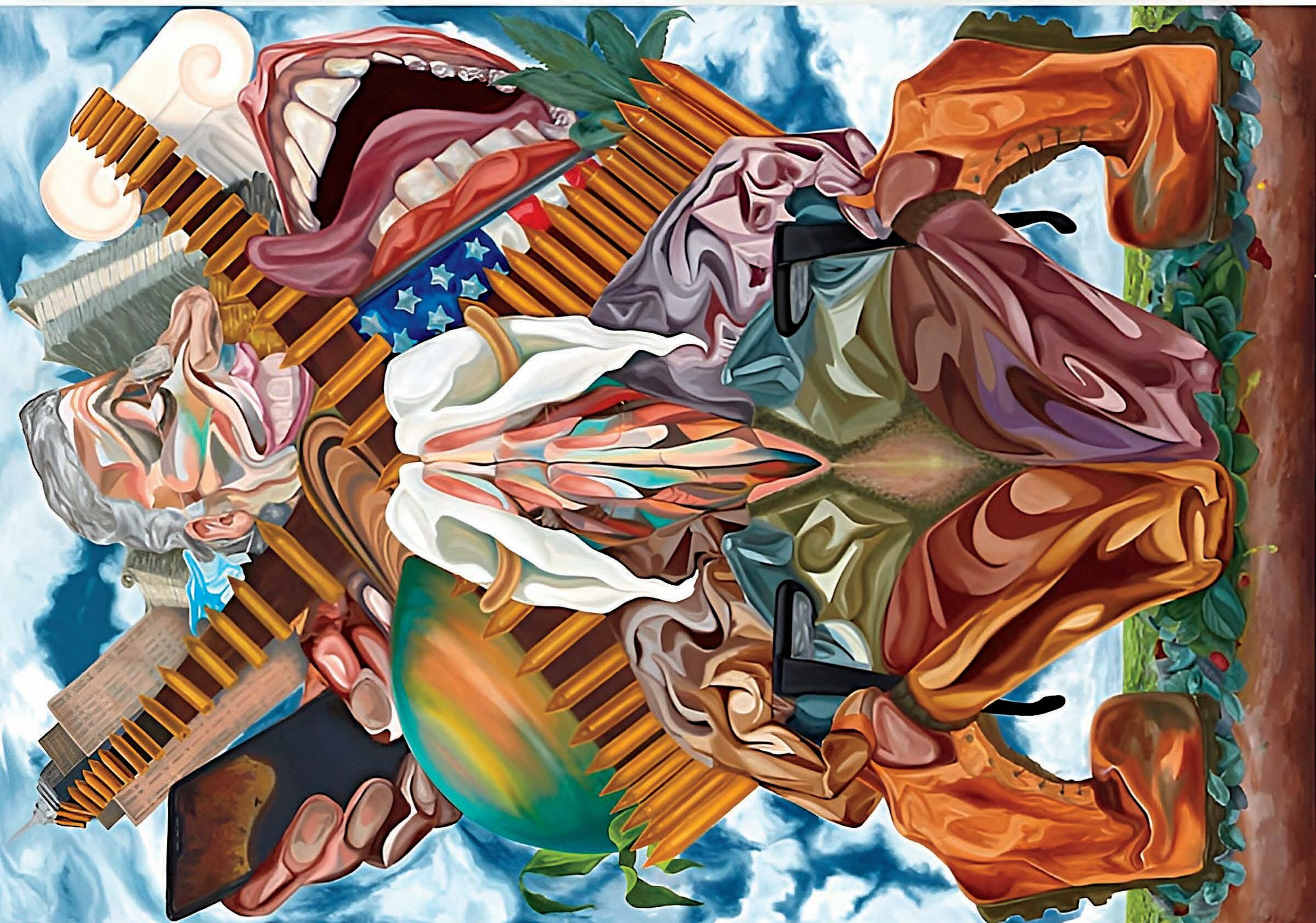
As he adopted a new canon, he began to receive attention, recognition, and understanding from his teachers. He had to mutate into something else to be understood. Once understood, his art created a new notion where his teachers gave him the freedom to be himself. He found a way to communicate the same message through a channel where the viewer could digest it. This speaks to his intelligence and empathy on his part. He noticed what his teachers were going to lean towards and transformed. He subsequently wonders if he accomplished this out of necessity, survival, or attention.
The capacity and talent he has to realize there was an opening and how to develop that to create a bridge between two cultures are reasons his art is so appealing. In one of his works, "Tequila Sunrise," he plays the guitar. And just like a Picasso figure, that painting becomes a ballot of these characters, of the options he had to perform to maneuver society. So there are layers and struggles we can discover in his work. You can deem there's a deep meaning. A heaviness to it, something at the bottom weighted, pushing to get out.
"Painting style, for me, wasn't a problem. It was, what is the most appropriate way to do this?"
During his thesis and after graduate school he was painting figurative work. He was referencing Norteñomusic.Itwasthemusichegrewuplistening to at home. His father was a musician and played Norteñomusic.
In the paintings, there is always a large figure with a big mustache referencing his father's likeness and theNorteñoappearance.
Norteño music is what he refers to as a synthesis of American, Mexican, and European sounds. He wanted the paintings to reflect the rhythms but also the synthesis of styles from cultures and their respectivelegacies.
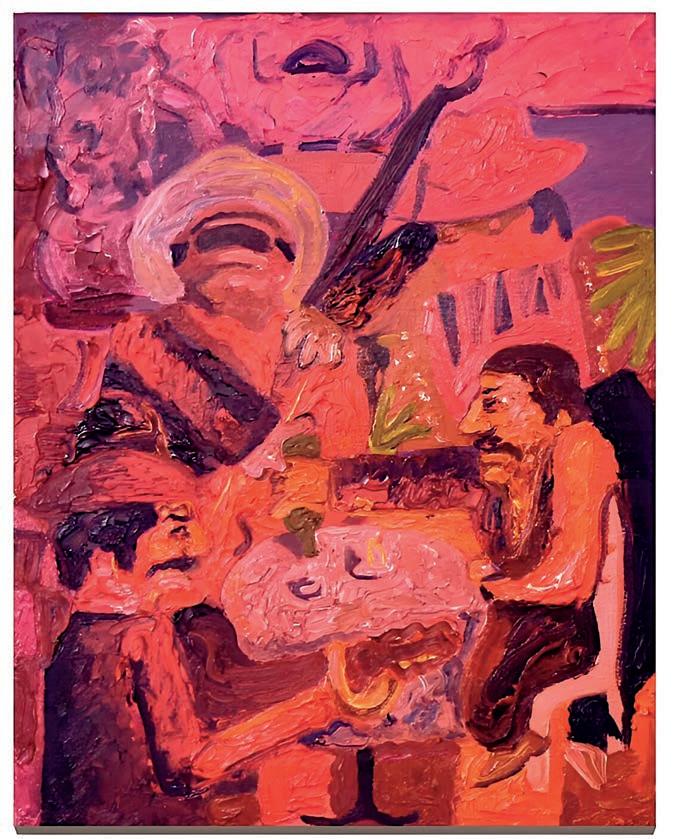
Content-wise, his art is about characters that he often switches on and off, as he previously expressed. He remembers during our talk, "Constantly,I'mbeinglike, "Well,today,I'mgoingtobemoreAmerican"There's astory,butthenarrativesarefracturedinhisart.It's putting pieces together because there needs to be moreclarity.
"I liked that there's no clarity, to me, that was the way I had to maneuver society "because of the community and the socialization of the characters thatweareallsortofassignedtobyhowwelookor identify.Thisthoughtmadehimponder.
Well, am I really looking? Or am I just seeing the world? Because if I'm seeing the world, I'm not experiencing anything new. I'm trapped in this glass prismofprojections,youknow?Sobecauseseeingis in the mind and looking where are your eyes are, right?"
It was important for Jose to uncover the distinction between seeing and looking and convert those observationsintohisart.
Part of the work or how he gets there is he converses with his inner child. He tries to connect childhood freedom and creativity to draw, just sit there for no reason to draw, draw, draw. Losing his imagination. He asks his inner child to take his adult self back to a time of freedom, inner peace, and no judgments. Not to think about colors or forms; just let it all come out. "I don't think about it. I pull the coloroutandjustsay,"Alright,well,Ilikeitlikethis.
I like it like that. Let's go there. And then, with color theory, we'll figure it out later. Talking to the younger self was a big part of alleviating a lot of anxiety from being a professional." Jose doesn't particularly like to mediate. But he does find clarity inhislifebydoingmundanethings.Thingswherewe don't have to think about anything. When we're on autopilot. "I believe there are little moments when yourbody,justyourmind,issorelaxedthatyoujust gettheidea."
He discussed the challenges experienced by the Latin community.
The people in the community who, don't have an education walk around with a language, ideas, and beliefs, at times inherited. Maybe they are not being who they can be because of culture and all the layers andbeliefsimplementedbyoursociety.Joseportrays"a differentunderstandingwiththescene,butnottryingto undo the scene." Mexican American artists and Chicano artistshavealwaysbeenmakingart.Dowewonderwhy these artists aren't recognized in the American art canon? The ones who grew up with many stereotypical images of Mexican Americans, Chicano culture, and lowriders. Maybe one of the reasons why not so many people know about history is because of ethnic cleansing after 1848 and colonialism, and the assimilationintoAmericansociety,andassimilatinginto differentreligions.JoseZunigaisasuccessstory.Butas he feels, "I also am a way a caricature of that success story, because I came from those neighborhoods of Chicanos and lowrider cultures and gang cultures and migrant workers. And I dressed that way. And I taught that at some point. And thinking in retrospect, it's hard formetogetoutofthesecharacters."
"I think a beautiful thing to do is to observe life. And to take that step, I'm going to call it a step up, not a step back, to where the air is a little bit cleaner. And perhaps you can pause and notice that so much of what we are and what we do is situational. And sometimes it's not ourchoice."
So, as I listen to his father's band, Los Cyclones, I get teary-eyed listening to his father sing "A rose in your hair looks like a star in the sky" as I remember how it is all connected and reflect on how precious all of these moments are and how important our roots are to all of us. When I was thinking of a title for this article, I was originally going to write Neither here or there, then I realized,heisbothhereandthereandputtinghisstamp on the world in a beautiful bridge he is building in culture, his experiences, his incredible talent and big heart.

"I think a beautiful thing to do is to observe life. And to take that step, I'm going to call it a step up, not a step back, to where the air is a little bit cleaner."
Jose Zuniga
 WRITTEN BY HEATHER ZISES
WRITTEN BY HEATHER ZISES
Chellis Baird explores the complex significance of the color red, while expanding upon her signature techniquesofsculpture,paintingandtextiles. Inspired by her favorite lipstick hue Lady Danger by MAC Cosmetics, the color explores a wide range of feelings and history, including contrasting emotions of love and pain, as well as symbols such as good luck, war and seduction. While some of Baird’s works hold the most potent and saturated layer of red such as cadmium, others retain faded versions of the hue like a pink ballet slipper. Included in this exhibition are Baird’s first silver gelatin prints of lipstick marks which embody what the artist dubs “a ghost of red.” The artist also developed her first metalandresinworkstitledSerpentineandFlirtwith a foundry in Long Island City. The overall body of work presented in The Touch of Red celebrates the many perspectives of the human condition that rangefrompassiontorage.

HZ: For this series, you make a departure from your creative wheelhouse by experimenting with new techniques and media like traditional photography (silver gelatin prints), gold leaf, and cast aluminum.Whatwasyourfavoritediscovery?
CB: To see my tactile, soft fabric presented in a hard material like aluminum, resin or plaster was so exciting. It has opened a whole new channel of inspiration and I can’t wait to develop this more. The bonded aluminum is resistant to weather welcoming the work to live outside or even in a high humid space like an indoor pool. I would love to create more outdoor works. To see the work in natural light is the most beautiful. The photograph offered a fun tongue and cheek layer to the overall presentation while being possibly perceived as a landscape or aerial view. I believe this is a way to share how abstraction can expand our perception
HZ:YoucreatedacustomizedshadeofredpaintwithMACCosmetics forthisexhibition.Whatwastheprocess?

CB: I love wearing Lady Danger lipstick by MAC cosmetics. I began by kissing different types of paper throughout the day in my studio while mixing paint. I noticed as the natural light shifted sometimes the cadmium hue became more pink or blue depending on the light. I began to mix different shades to evoke the color’s complexity and worked with a paint store in New York and Georgia. Lady Danger I is a mid-day pink and red twist while Lady Danger II has a more 2am seductive allure. The compositions were inspired by the way one’s mouth moves throughout the day.

HZ: The beginning of your exhibition presents a curve ball inthesensethattwonon-redworksflanktheintroductory wall text; Serpentine, 2021 (cast aluminum) and Pout, 2022(asilvergelatinprint).Thisrecallsaheadyconceptin your artist statement about a black-and-white version of red–somethingyoucall“theghostofred”–insomeofyour pieces. This could be interpreted as a visual palate cleansertopreparefortheshow.Whatwasyourintention withthisunexpectedinstallationapproach?
CB: Red lingers. Think of a hot room and you leave and yet feel red without actually being red. I wanted the viewer to stop and think what is red for them? What experiences of red have they seen?Theworksonthiswall–SerpentineandPout–bothoffera historyofred.IthinkofSerpentineasbeingawarmembraceor hug like quality. The word ‘serpentine’ can mean a long winding road or path. If you think of the way these roads or paths circle around us like a hug. Pout is an abstract photo of my lips. This was created by kissing the paper with my Lady Danger lipstick on, and then blowing it up and re-photographing in black and white. The contemporary image presented in the classic silver gelatinoffersatwist.

HZ: TitleslikeSensation,Flirt,andBettyBoophavearetrochicsensibilityinaveryavant-gardeera.Thatsaid,didthe globalneedfornostalgiaduringthepandemicfeedintothe genesisofthesetitles?
CB:Perhapsthereisabitofnostalgiapost-pandemicandduring the pandemic. I think for me Betty Boop has many facets and layerslikethecoloritself.ItwaswhatIcalledmyGrandmother,it was a favorite childhood cartoon, and I always think of her in a red polka-dot dress. The cartoon character offers the duality within red to be both flirty and naive, and also a femme fatale. I lovethismultifacetedcomplexity.
HZ: There will be an interactive element with Pout (2022) at the opening reception. Can you please elaborate on this?
CB: A series evolved during my exploration of red titled Lady DangerinspiredbymyMAClipstick.Thedailyritualofthistouch of red offers many interpretations. During the reception MAC cosmetics sponsored an interactive artwork by inviting viewers tocolorinaprintofPout.Poutisthesilvergelatinphotoofmylips. FollowheronInstagramtoseethefinalwork!@chellisbaird
"I hope the tactility of my art is a reminder of the importance of the human hand and touch. Life is about relationships!"Photo courtesy of the artist
Heather Zises: How did the idea of creating a show centered around your favorite color evolve?
Chellis Baird: I always wanted to create a show around my favorite color. I have been searching for the best way to present this in a space that has intimacy and gravity. The West Gallery at The National Arts Club is centrally located to the building’s foundation. This central location feels almostlikethecoreoraninternalspacefullofwarmth.Redencompassesopposingpositionslike sweetness and seduction or war and good luck. I am drawn to its complex history and alarming nature. I somehow find it calming and yet full of surprise. A series evolved during my exploration ofredtitledLadyDangerinspiredbymyMAClipstick.Thedailyritualofapplyingthistouchofred offers many interpretations. During the reception MAC cosmetics sponsored an interactive artworkinvitingviewerstocolorinaphotoofmylips.
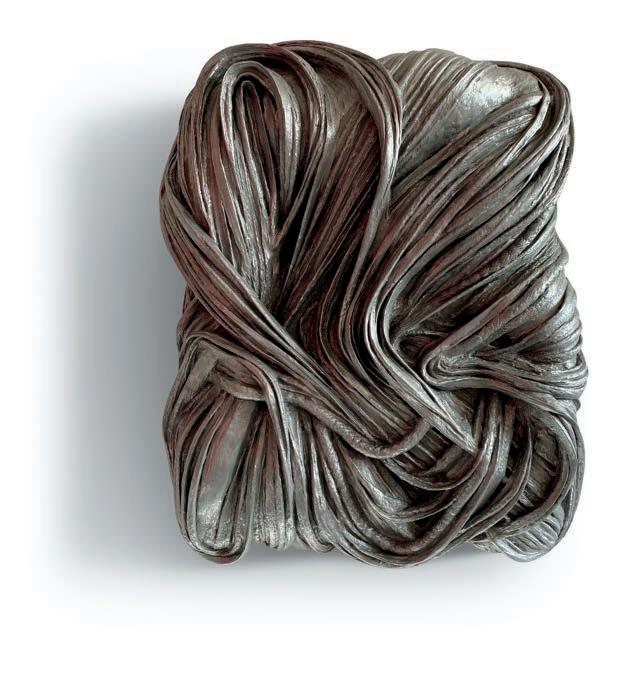
HZ: Some adjectives that come to mind about your work are bold, elegant and textural. How mightyouexplainyourworktosomeonewhoislegallyblindorhasneverseenitbefore?
CB: The work is full of movement and winding turns and paths that seem at times separate but then are all simultaneously connected. The shapes are organic like water or muscles. I use my dance practice to create drawings in space. The articulation of these gestures are where my abstract forms begin. Sometimes when I am creating my compositions I close my eyes and draw in space and imagine what a texture or gesture may convey. I would love to create a show called Don’t Touch! and every hour the lights go out and everyone touches the works without being abletoseeanything..
HZ: The National Arts Club is a historic organization in a landmark building in Manhattan. How did these cultural strands influencethestagingofyourshow?
CB: The back restaurant has a gorgeous inlay of fruitwood that has been hand carved into floral design with gold leaf surrounding the edges. The textural wood has a similar surface to my textural paintings. I began to research the best gold leaf suppliers in the city and had a workshop with Sepp Leaf. The historical family run company supplies many artisans, architects, and artists with an array of golds from around the world. I was immediately drawn to the 23K redgoldleaffromFlorence,Italy.Ithad1.5percentcopperinit,offering enough warmth to complement the red, while being a small enough percentagetonevertarnish.
HZ: The Touch of Red celebrates the many perspectives of the human condition through passion, love and warmth. What messagedoyouhopethisexhibitionwillcommunicate?

CB: We make many decisions in life based on color. It is such an emotional facet to our choices of which we are not always aware. I hope viewers leave with a new experience of the color red and a new appreciation for their own color choices. All of my work leans toward the analog realm as it is deeply rooted in physical gesture in today’s digital world. I hope the tactility of my art is a reminder of the importanceofthehumanhandandtouch.Lifeisaboutrelationships!
American artist Chellis Baird blurs the intersection of painting, sculpture, and textiles. Baird explores the elements of painting by reconstructing handwoven canvases from a unique perspective. Her bespoke process begins with woven structures as her base. Each canvas starts with neutral-toned materials that are then painted, dyed, and sculpted into dimensional brushstrokes. She creates tangled compositions through a series of twists, knots, and upcycled textiles. Baird’s background in fashion allows her to dress the canvas with imagination. Not unlike a garment, she uses color to emphasize the authenticity and body of each piece.Baird received her BFA in textiles from Rhode Island School of Design and studied studio art at the Art Students League in New York City. Baird’s first solo museum exhibition, TETHERED, was held at the Myrtle Beach Art Museum in SouthCarolinafromSeptember7–December19,2021.Mostrecently, the artist was awarded a 2022 fellowship at the National Arts Club. BorninSpartanburg,SC,BairdnowlivesandworksinNewYorkCity.

